#based on the vocaloid illustration. you know the one.
Explore tagged Tumblr posts
Text

cendrillon au!
242 notes
·
View notes
Note
Do you have info on commissions in general? such as 2dmvs, songs, etc. Anything released by the devs about stuff like what it takes to commission artists for content that’ll be used ingame, how long in advance the creator that’s being commissioned has to be contacted, have there been any rejected/remade commissioned songs, etc etc.
I’m particularly wondering if there’s disclosed info about the song Order Made and any other commissioned songs that had the Sekai version vocaloid tuned by the producer, because how would the game’s management arrange for that?
Here's some stuff I know
Most of this is taken from the Corocoro producer interviews, and you can find them all here. I mainly just skimmed them for trivia, but they're worth a read and there's probably some stuff I missed.
According to devs, the process of commissioning and producing songs can take around 8 months, though according to individual producers, the production of the song (not including recording vocals and mixing) can take anywhere between days and about a year. Producers are given a story summary, along with some words and phrases that staff would like to be reflected, and then given free reign on the rest (though management does oversee things)
In addition, event plot outlines have to be finished by the time the producer is commissioned for the event song, although this definitely didn't seem to be the case earlier on in the game, as you'll see further down this post.
According to Project Message vol.15, earlier commissions would have their SEKAI version Virtual Singer picked based on the producer. This is why Nijiiro Stories has two Virtual Singers, as staff decided that MEIKO and KAITO fit the image of OSTER Project best.
Both TONDEMO-WONDERZ and Showtime Ruler had their first drafts scrapped. Tondemo was because Sasakure didn't like his early drafts, but Showtime Ruler's first draft was rejected by staff because they didn't think the style was right.
Surii actually made two versions of Kagirinaku Haiiro e. He asked staff to pick which one they preferred and that's the one in the game.
DIVELA wrote two songs before Tenshi no Clover
Depending on the artists, the song can take a matter of days to compose, or months. For example, DECO*27 composed needLe in 3 days, but it took Giga 6 months to finalise Ready Steady.
Here's an interesting one. Karasuyasabou looked at fans talking about WxS stories to help him with writing the lyrics to Showtime Ruler, alongside reading the stories himself. He describes the song's lyrics as being "written with the fans".
There's a bit of a grey area in how things were handled early on. For example, DECO*27 mentions in his Corocoro interview that he was given character illustrations and he talked about story, suggesting that he was given something to work with there. However, PinnochioP mentions only being given the prompt of "abandoned theme park" and some character designs, and NayutalieN mentions only being given character designs because things weren't set in stone at the time (I think NayutalieN was approached very early).
So yeah, MORE! JUMP! MORE! was written with no knowledge of story. NayutalieN was informed of things as they progressed, but it was still vague details that he was given. Also mentioning fragments of feelings in the lyrics was a complete coincidence.
OSTER Project mentioned in her interview that On A Holy Night, This Singing Voice had not been completed when she was commissioned, so she also worked from very vague details.
40mP was another producer who was approached long before release
SEGA specifically asked 40mP for a song with a "serious story" but "not too dark" (same link as above)
Meanwhile, HachiojiP was advised to add classical elements to RAD DOGS fit the event story
Ayase was contacted long before the release of the game as well, despite his song not releasing in-game until quite a while after release.
Ayase also was given the privilege of choosing what unit he got to make a song for. He chose VBS because he thought they fit hit vibe most and because he thought they were cool.
Police Piccadilly was requested to make a song that wasn't "too agressive or over-the-top"
Aqu3ra was given a bit more free will though, and was just told to make their comm sound how they wanted it to
They also made two demos, and after consultation with staff, chose one of the demos to finalise
TOKOTOKO was told to make "a song that would be exciting in live performances". As you can probably tell at this point the prompts received can vary greatly between producers.
there's not a huge amount of information outside of the corocoro interviews, and they've only done up to Yuukisan (Mirai) so far, so there's limits on how much i can tell you. Also not every song got an interview, so now Nulut, no Mafumafu, no Neru unfortunately. I suggest to keep an eye out for new interviews if you're interested; they seem to be going at a pace of one or two per month.
#asks#songs#karasuyasabou-san why did you do that to yourself#sorry this took so long orz#i started this in september i think and just never got around to finishing it.. apologies for making you wait so long
146 notes
·
View notes
Note
Hi! Do you have written explanations for the Cringetober themes? I understand you already have made a video where you explain the themes but because English is not my first language it's sometimes hard to understand everything from just speech.
I didn’t until 2 minutes ago, but here they are!
screenshot redraw - something easy we have screenshot redraw, this can be from a TV show or cartoon or movie or whatever. you can replace the characters or just redo it in your own style
tsundere - a tsundere is the trope where a character, usually a girl, pretends to find their love interest annoying out of embarrassment for their crush
oversized prop - pretty straight forward. love a good disproportional hammer
fursona / fursuit - first bit of encouragement to explore outside 2D illustration. i know full suits are expensive, so let this be your sign to make or design a partial yourself out of whatever you have lying around; cardboard, fabric and wire, even paper. of course, you can stick to drawing your fursona
gjinka - it's a humanization of anything, whether that be a pokemon or other monster character, an animal, a concept or emotion like inside out, an object or even something like an app
unnatural eye color - fairly straightforward, character with weird eyes
crossover - characters from different media interacting with one another
dead meme - perfect opportunity for people like me who see a meme or trend going around and then, by the time they get around to it, its well run its course
childhood videogame - this can be any game you played when you were younger, but i was specifically thinking of stuff like pokemon, sonic, mario, minecraft, five nights at freddy's, or undertale
ship dynamics - a relationship dynamic or overused cliche
5+1 things - fairly common trope in fanfiction, it refers to a character or characters experiencing 5 similar events that all go roughly the same way, as well as another similar event that this time ends up pretty different. it can be happy or sad, and of course you can stick to a comic or illustration, but fanfiction or creative writing in general is often looked down upon, so i think y’all should at least try to write something
hatsune miku / vocaloid - any vocaloid, doesn’t have to be part of the main vocaloid suite. people make cool interpretations of hatsune miku’s design specifically, but you can do any character you’d like
rule 63 - for every male character, there exists a female counterpart, and for every female character, there exists a male counterpart. basically, genderbends
incorrect quote - you can depict a character (original or not) saying any kind of iconic quote that you think suits them
animation meme - most classic animation memes are actually really simple with somewhat jerky movements, which is ideal for those just starting animation. if you've always wanted to animate but the concept seemed too daunting, here's the opportunity for you! of course, you can just reference popular animation memes with a still image if you’d prefer
something you've been bullied for - there are a lot of things that are considered cringe that a person can't change about themselves, even if they want or try to. i didn't want to single out any specific insecurities, so i left it broad enough for it to apply to everyone. it's kind of like a free space to celebrate anything about yourself that you've felt ashamed of
f2u base - f2u stands for 'free to use', basically an empty sketch you can use to draw whatever characters you want. this can be interpreted as either making or using a free base, so do whichever one you'd prefer. if you're using a base, just remember to credit the original artist if you post it
Fandom AU - good simple fun. draw characters you like from a piece of media you like in any alternate universe you like
alternative fashion - your opportunity to experiment with a fashion style you've always thought was cool but were too nervous to try. alternatively, (haha) draw a character in alt fashion
tumblr sexywoman - a female character that is, for whatever reason, incredibly popular and found attractive
closet cosplay - build a cosplay using only things you already have in your closet! I wanted to encourage people to get into cosplay since it’s such a fun hobby
candygore - gory drawings that involve pastel colors and sometimes literal candy iconography
adult cartoons - cartoons intended for older audiences, ex. Hazbin Hotel, Smiling Friends, Amazing Digital Circus
niche interest - another free space that lets you make something relating to a pretty unpopular or not very well known thing that you really like
gacha life (I spelled it wrong on the list) - it’s a website where you can design characters and move them around and make up stories. it was super influential for a lot of artists
Y/N or Mary Sue - could be a male Mary Sue too. A very overpowered, perfect character. Alternatively, you can interpret this as literally “your name” and insert yourself into whatever media you want
YouTuber fanart - do some fanart for a YouTube channel you enjoy, whether that be for an art channel, a commentary or video game youtuber, or sketch comedy
mascot horror - anything relating to horror that involves cute marketable characters. FNAF, poppy playtime, Amanda the adventurer are all some examples
experimental makeup - trying out a makeup style that you haven’t done before. of course, if you aren’t comfortable wearing makeup, you can totally draw a character experimenting with their own makeup style
supernatural or monster character - demon, vampire, werewolf, fairy, or any monster type character you can think of
HALLOWEEN - anything spooky to celebrate Halloween!!
While I hope this compilation was useful, please remember that all the prompts are completely up to interpretation. There are no rules to Cringetober! Just do whatever you want and have fun :)
24 notes
·
View notes
Note
plz share your miku essay 👀
DISCLAIMER. this was written in the throes of 2020 lockdown fever and it shows lol
THE GIRL WHO’LL LIVE FOREVER
until tonight, i didn’t know hatsune miku wasn’t real. my hazy assumption was that someone ‘played’ hatsune miku in the same way that mark ruffalo plays the hulk - i thought there was an actress out there who provided the basis for her body and voice. i was right about one of these things, but only accidentally, and remarkably wrong about the rest of it. i am writing this because a) i have literally nothing else to do and b) because i thought the rabbit hole i just fell down was really cool! cool, strange, fascinating, and also kind of sad. anyway. close your eyes and pretend it’s 2007:
yamaha’s vocaloid software is grounded in the concept of ‘voices’. there’s the VOCALOID program itself, the act of writing music that can be played by a machine, and then there are the voices you can use to synthesise it. in 2007, there were 3 voice banks available: a western voice bank named ‘sweet ann’, CV01, and CV02.
CV01 (character voice 1) was developed by crypton media as the first japanese voice bank. character voice 1, as names go, is not particularly appealing - so to increase interest in VOCALOID software and attract a userbase willing to learn it, the team behind CV01 decided to put a name and a face to the voice they’d created. it went, from what can be discerned via google, the wayback machine, and a scattering of translated interviews, something like this: hatsune miku’s voice was based on vocal samples given by saki fujita, a well-established voice actress and living human being. the voice bank itself was built by designer wataru sasuski. her physical appearance, including her iconic outfit and improbably huge aquamarine pigtails, were created by kei garou, a cartoonist and illustrator. everything else was left intentionally as a blank slate - and in the ensuing years, her cult following of fans have risen to the challenge of filling in the gaps. for better or worse.
one of the few canonical facts about hatsune miku is her age. she is, according to her creators, a sixteen year old girl from a distant future where music was forgotten. her outfit reflects this, styled in a fashion reminiscent of seifuku-style school uniforms: skirt, shirt, stockings, and a tie. i did not know there was a specific word for that until just now. anyway - hatsune miku was sixteen in 2007, and she has been sixteen ever since.
i have watched… more than a few vocaloid AMVs tonight! the oldest ones resembled a cross between second life and final fantasy 8 cutscenes - bizarre, rigid avatars performing bizarre, rigid choreography in a number of inexplicable locales, such as endless fields of wheat, a gothic cathedral, and (most memorably), a busted nuclear reactor - but eventually i reached the live recordings, which is where things graduated from funny-weird to weird-weird. the production value, compared to those early videos, was off the charts. the songs, as far as i could tell, were the same. this is often lauded as one of the most unique, inimitable facets of the ‘miku experience’ - her songs are written (and choreographed) by her fans. world is mine, one of her most popular live performances at 8 million hits, started life as one of those stilted, second life-esque animations.
so miku’s songs are written by her fans. hatsune miku, the character, the experience, the mythos - is collectively created by her fans. which begs the question: who are her fans? who created the youtube videos? who has the time, resources, and sheer dedication necessary to create AMVs for an ever-young, ever-pleasant, angel-voiced teenager, with a sylphlike body and a skin tight school uniform?
i didn’t make the connection, at first. maybe this was naive of me. while absorbing the first few miku live videos, hearing her babytalk, watching her perform - my initial assumption was that miku audiences would primarily be teenagers (and their grim-faced parents), people who could relate to miku as an aspirational ‘peer’. her dance moves, especially, led me down this route - is fortnite still big with the youth? i’m 22, i have accepted that my days as someone who knows What’s Big With The Youth are behind me, but i still hear vague echoes from time to time. fortnite dances. tiktok. hatsune miku. etc. what was i saying. oh yeah. miku dances with a camera in mind, the way a tiktok influencer dances: effervescent, front-facing, with hand gestures that beg to be imitated. the more i watched her the more i recognised the unnerving, uncanny quality emanating from the stage. i realised where i’d seen it before. we live in a remarkable age of animation: where AAA studios are creating death scenes so realistic they can provoke a trauma response in the people animating them, where a horse’s bollocks will infamously shrink when exposed to pixel snow, and where hatsune miku dances with unerring, flawless fluidity, while the gleaming stage lights fall perfectly on her virtual body.
she looks so at home in 3-dimensional space, especially in the newest videos, it's easy to forget she isn't there. she looks real. like you could touch her. she will never, of course, be real. you will never, of course, touch her. but you can touch her in other ways. you can write songs with her voice and make her dance to them; you can manipulate the movements of her body, every minute bob of her pigtails, puppet her, propel her. is that the appeal? is that why her audiences look the way they do? i am thinking about tabula rasa and whether the miku slate was ever truly blank. it makes me sad. there’s something poignant about the intersection of humanity and technology that vocaloids represent. they were the first crossing of a border that will continue to be crossed for the rest of the 21st century. in a virtual age, with virtual bodies, what constitutes as ‘real’? where, and how, do we draw a line?
to my surprise, there is a miku song i genuinely like: ‘miku’ ft. hatsune miku, by anamanaguchi. the music video strips the avatar away and leaves the voice bare, nothing but the blood and guts of a vocaloid, synthesizers and computers in an empty recording studio - and this nakedness simultaneously dispels and intensifies my discomfort. it reminds me that the miku vocaloid is more than the sum of its parts. despite the controversy surrounding the fanbase who propeled hatsune miku to fame, there is still something undeniably compelling about this. about her. maybe it’s that animal hindbrain piping up, pricking up the hairs on the back of my neck: this is not a human voice. this is something other, something new. the lyrics do not shy from this. miku, miku, what’s it like to be you? followed by, play me, break me, make me feel like superman, you can do anything you want - and, most poignantly, you found me here inside a dream, walk through fire straight to me. fire walk with me. miku’s existence is a lynchian fever dream; and what’s more, in this song, she knows it. i’m not saying hatsune miku and laura palmer need to be compared and contrasted. but i’m also not NOT saying that. i am saying that this song, like every other miku song, is the catchiest song in the world. like it was developed in a lab to be an ear worm. i suppose, in some ways, that’s the point.
#as a reminder to anyone reading this I HAD NOT BEEN OUTSIDE FOR DAYS. i was not SLEEPING. i wass DEPRESSED. i was REWATCHING TWIN PEAKS#ask#anonymous
46 notes
·
View notes
Note
Do you mind explaining what evillous is? It looks like miku, rin and len to me? is it just a vocaloid song that they were given unique identities in?

evillious (or the evillious chronicles but that's too much for me to be bothered to type out again and again) is a massive multimedia franchise made by the vocaloid producer mothy!
the vocaloids basically serve as actors in it which is why most characters look a lot like their corresponding voicebanks.... but also the close resemblance the characters can be 50/50 like on one hand you have michaela who looks JUST like miku but on the other hand you have ma who's a luka but looks.. nothing like a luka (tbf that is bc of bodyswapping but also like . come on . the girl she bodyswapped with was also a luka) and then there's characters like bruno who, despite being p fucking important, doesn't have a vocaloid at all
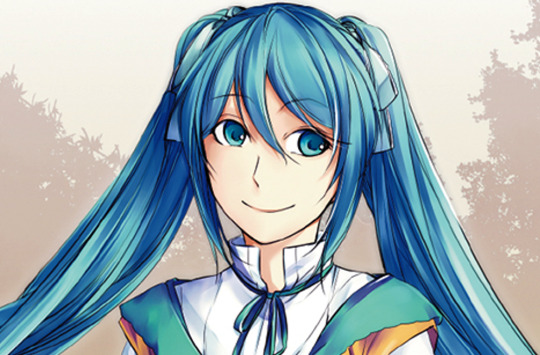
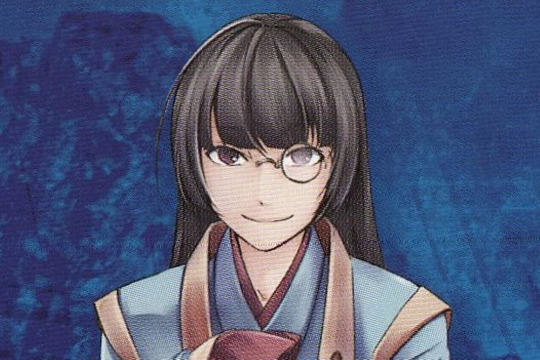
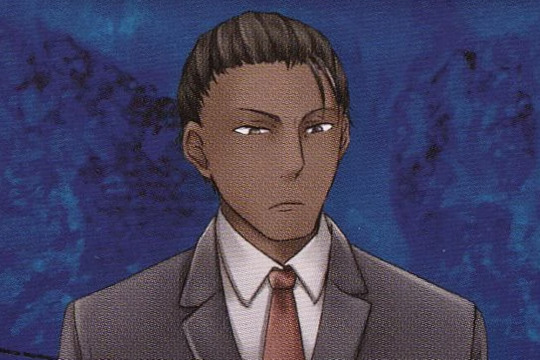
^^ michaela, ma, and bruno
but also i think the reason riliane, allen and michaela look so much like their vocaloids in those figures is bc they're meant as 'rin in this one song', 'len in this one song' and 'miku in this one song' and not 'riliane lucifen d'autriche, a character who has 5 light novels, a bunch of manga volumes, and too many songs to count that are all primarily about her' etc etc (i'm not calculating allen and michaela's appearances or the amount of manga volumes riliane is in you could not pay me to (actually you could and i know the exact price but no one's going to)). also the evillious characters all have p defined facial features that get ironed out when they get converted into generic anime figure style.
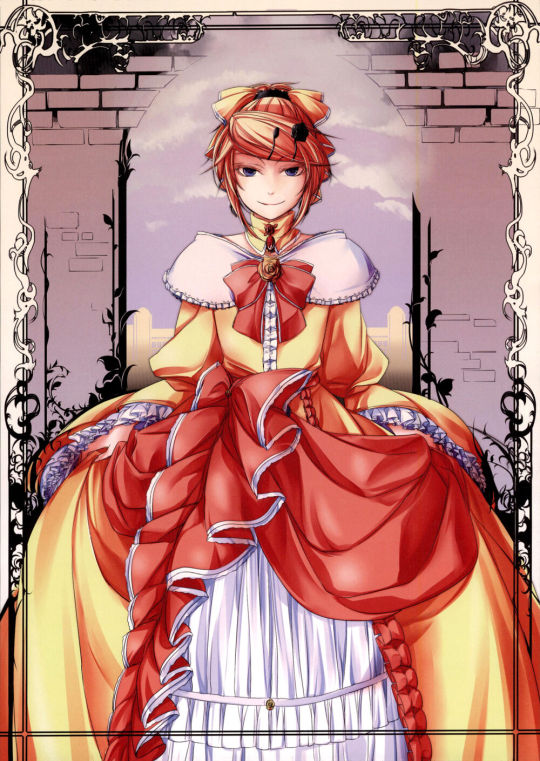
^^ maybe my perception is warped as an evillious fan but i do not ever see ichika's illustrations of riliane and think 'that's kagamine rin'
in regards to what evillious actually is though, it's also known as story of evil and the seven deadly sins series, and if you're into vocaloid (esp if you've been into vocaloid for any decent amount of time) whether you know it or not, you are very, very familiar with at least a little bit of evillious. and by that i mean you've heard daughter of evil at least once, and also probably servant of evil, the tailor of enbizaka, the lunacy of duke venomania and judgement of corruption. the story basically follows this world known as the third period from its creation to its destruction (and a bit before and after). the seven deadly sins series makes up the bulk of evillious and follows seven people at different times and locations throughout this world's history and those around them as they get possessed by the seven deadly sins and uhm . well it should be p obvious that nothing good comes of that. story of evil is a colloqiual name given to the pride arc bc daughter of evil, servant of evil and regret message were the first songs mothy released that were explicitly meant to be tied together upon release (he likes to drop a song and then be like 'teehee this was part of the evillious canon all along' years later) and the evillious name wouldn't come around til much later.
if you want to actually get into evillious, you really have to go by release order or you will get very confused very quickly (gasp! the guy who likes fate enough to run a daily blog based around it for over a year has strong opinions on that age old issue of watch order (not the right phrase bc i am a fate anime adaptation hater til the day i die and the evillious anime never actually got made but. you know what i mean)!) mainly bc of the sheer amount of body swapping and reincarnation that goes on and the scifi fantasy concepts that get explained when they first appear and then never again. the songs all have translated pvs up on youtube (a lot of pvs are fanmade and may have aged poorly w noncanon visuals so don't fully let your guard down) and most if not all written materials have tls by @/pricechecktranslations here on tumblr. obligatory warning for a lot of incest and also everyone fucking dying goes here, there are more cws that should be attached to it but we'd be here literally for fucking ever if i were to list all of them bc it's huge and every bad thing happens at least once but those are the two big ones that happen in most if not all arcs.
#asks actually tied to the theme of this blog get to rot in the askbox forever but 'what's evillious' gets answered in a few hours#tbf to me i think the askers who keep things actually tied to the blog theme follow me and are likely to see it if i answer it late but i#think the two anons above are just passing through from the other figure blog so it's now or never#not figures
12 notes
·
View notes
Text
The heavenly yard blog infomine, part 6: More Songs, and the Daughter of Evil Musical (no, not that one)
Some more interesting stuff in this one--starting to get closer to mothy conceptualizing Evillious as we know it, though of course we're not quiiiite there yet.
2 October 2009 ~ 25 February 2010
---October 2009---
2nd
-mothy releases Heartbeat Clocktower and To You of Few Words on Piapro.
-He releases a few more Evils Theater CDs by popular demand.
11th
-More Daughter of Evil on MikuMoba
19th
-Daughter of Evil is getting a chibi figurine!
-mothy shares some clips of two new songs he's working on. The links are defunct so I'm not sure which ones they are.
---November 2009---
8th
-mothy has been working on quite a bit, but a lot of it involves things he's keeping under wraps for the time being, so he hasn't had much to blog about. he's working on another song in addition to the previous two he shared clips of, and considering soliciting illustrations for it on Piapro (I think based on that, and the timing, that this one is Tailor of Enbizaka).
-Someone mentions an unofficial performance of his work in the comments section. He thanks them for the notice and lets them know they're more than welcome to do so, but has to keep the actual announcements on his blog limited to works he's officially affiliated with considering the sheer scope of derivative works being made at the time.
11th
-I was correct, the song he's soliciting illustrations for is Tailor of Enbizaka.
-The recruitment system has apparently changed since he last used it, so he's not sure if he'll get the same turnout as before.
19th
-mothy announces an upcoming play adaptation of Daughter of Evil, ~Gemini of Charm~ (Charming Gemini? Not sure I like this translation in hindsight).
-This is notably not the first of its kind, but it is the first one that he's involved with in some capacity. He hints at the play revealing content that wasn't in the songs.
-Note, the link to the website still works.
-There's a comment that asks if he's ever going to make songs with UTAU. He says that while he is interested, he doesn't have the time to learn how.
28th
-Daughter of Evil has 1 million views!
-In other news, there are plans to release a DVD version of the upcoming DoE musical.
-Meanwhile voting for Conchita, moonlit bear, Re_birthday, and Screws,Gears, etc is going to start up for entering them into JOYSOUND in December.
---December 2009---
4th
-Daughter and Servant of Evil are both going to be on the VocaloLegend CD.
-mothy has finished recruiting illustrations for Tailor, and is working on putting the video together.
8th
-mothy has uploaded Tailor!
16th
-Tailor has reached 2nd in the weekly rankings! And Clockwork Lullaby has reached 100,000 replays.
-mothy hopes to upload some more videos this month.
-in responding to a comment, mothy reveals he has difficulty participating in winter comiket because it conflicts with his day job.
25th
-Tailor has reached 100,000 views!
-mothy announces the tie-in soundtrack album he's put together for Gemini of Charm/the musical
27th
-In celebration of the Kagamine Twins' anniversary, mothy uploads the Velvet Mix versions of both Daughter and Servant of Evil to NicoNico (with illustrations from Piapro)
-mothy expresses plans to release a mini-album at VOCALOID Master 11.
29th
-mothy announces Regret Message is going to be in the Stardom3 album.
---January 2010---
1st
-mothy does a little retrospective on the songs that he released in 2009 in honor of the new year. I won't summarize all of it but some highlights:
-he had a lot of fun making Conchita, he didn't struggle with writing it like he does some of the other songs.
-he hadn't actually intended moonlit bear to be so dark.
-Heartbeat Clocktower is still just on piapro for now.
-his setting and concepts for Screws, Gears, and Pride is actually quite detailed, but he doesn't know if he'll ever get the opportunity to share any of it.
-he says he wrote "to you of few words" to himself, in a way, that he has to write songs like this every once in a while.
-he thinks he may have gone a little overboard on Tailor.
-Confirms again that Rin and Len are his favorite VOCALOIDS.
5th
-Re_birthday and Conchita have made it onto JOYSOUND. Voting is still ongoing for the others.
6th
-mothy uploads Daughter of White.
9th
-mothy thanks people for the comments on Daughter of White, noting he had to cut a very large amount of content for it even with how long the end result was.
-He also shares a few videos made by the illustrators that he was working with (Ichika and "The one who loves the Oni", You-ring and "Pretty Panties ☆ AkuMaRin", Suzunosuke and "Synchronicity", and Painter-Brioche with "Lonely Runner"
16th
-Daughter of White has topped the VOCALOID rankings.
-Meanwhile, mothy talks plans for VOCALOID Master 11, where he intends to release the Prelude to Forest album. He also talks about the big collab CDs that he's involved in (VOCALOlegend, Stardom, Supernova, etc).
-The musical date is also fast approaching. Mothy says that while the setting, character names, and general plot ideas come from him, the script itself was largely written by the theater company.
23rd
-Mothy reports back from the stage rehearsal of the DoE musical. He thinks they did a good job incorporating his ideas with their own original material. Asami Shimoda attended to (apparently she got a RinLen plushy(ies?) from Crypton.
-He advertises "elements", which is a--I think CD? Performance? of some kind that Shimoda was doing. The website's defunct now.
---February 2010---
2nd
-The DoE musical has premiered, mothy shares his thoughts.
-He liked it, thought it was written and performed well. It sounds like Josephine had an active role (like she does in the newer musical). As an audience member it was apparently very entertaining.
-As the author of the original work, he thought it was good as a stage play. There were a lot of deviations from his own story ideas (apparently the scriptwriter did this on purpose to make it stand on its own rather than trying to compete with mothy). mothy's thinking is that the adaptation should try to recreate the tone of the original, but keep in mind that stage performance and songs are two different styles of work, so it's understandable to pursue what works for stage itself. And that the differences where Daughter of White are concerned are only natural since that's a newer release that didn't exist when this was being written. They only had a basic summary of Clarith's character at the time (note--mothy shares the specific description he gave them, and it does mention her and Michaela by name).
-He makes clear that not all of the elements that show up in the musical but not the songs are original--that is, he gave them some story elements to use that weren't in the songs. He lists off the names of Riliane, Allen, Germaine, Kyle, Michaela, Elluka, Clarith, Chartette, and Ney as names that come from him specifically. And then the Three Heroes and whatnot. Though the characters who aren't in the songs are very different in the musical, like Chartette for example.
4th
Part 1
-(as a note, as mothy discusses the musical, he is also sharing pictures of himself with the cast of the musical, covering his face up with a logo of course)
-Continuing on the topic of the musical, there is a ton of plot mothy's come up with that hasn't made it into the "Akuno" songs. Some of these are spoilers. Mothy compiled all of these ideas during the collaboration, and now he's wondering what to do with them. He wants to share them in some fashion. He could make them into songs but that might take a while, and he wants to do more than just the "Akuno" series. This is something he hopes to work on this year.
Part 2
-Mothy announces that the musical's soundtrack CD has been released for purchase. Asami Shimoda has some vocals on it.
Part 3
-Mothy talks about Twiright Prank, which is the new song in the musical that he specifically wrote for it. He was nervous working on it because he's never written a song to someone else's specifications before, but it turned out okay. He explains the plot a little, and his plans to make a RinLen version (of course he demo-ed with RinLen but he didn't tune it or anything)
-He also missed the "Akuno" series showing up on CountdownTV (idk what that means)
Part 4
-Mothy is attending VOCALOID MASTER 11 on Sunday. It's his first time going alone, under the Heavenly Yard label. He will, as stated before, be selling the new album Prelude to Forest, as well as other stuff.
8th
-VOCALOID MASTER went well, as expected. Mothy sold out, but he'll be selling some things on consignment in the usual places. He'll also be selling at VOCALOID PARADISE 3 in March.
25th
-mothy announces he'll be releasing Full Moon Laboratory in March for the Supernova2 CD.
-Some comment replies--he gives permission to do derivative and parody works on NicoNico. He can't sell his works on Amazon because they're self-published. And so on.
26 notes
·
View notes
Note
hey miku is 16 jsyk!!
Anon, I'll be honest I'm not fully sure what your intentions are with this message… I've been in the Vocaloid, UTAU and Vsynth trenches since 2010. That may not be 16 years worth of time here, but it's still a long time to be a fan of one thing considering it's about half the time I've been alive. So that means I'm going to impart some knowledge here that newer Vocaloid and Miku fans may not understand (Especially anyone coming to my account after being introduced to Miku through Project Sekai).
Miku is, by all definition, an instrument. A voicebank is an instrument. It is a tool used to create music. The only thing that truly sets her apart from other electronic instruments or music making software is that she has a 2D mascot assigned to her to make her more marketable. That mascot was meant to be 16, yes. I will not deny that fact. Her voice bank even turned 16 years old this year since she was released way back in 2007! Happy 16 years of physical existence to your original disc-based software, Miku! So her Mascot associated as the face of the voicebank is 16 in both her physical age since launch and what's included in her original bio in that software and on the Yamaha website. If you wanted to say she was 16 years old at birth, then she'd actually be 32 years old this year if she actually aged. But her mascot doesn't age, just like all mascots of goods and brands do not age (Except for the Planter's Peanut guy I guess???). If this was a character from an anime that was always portrayed as a 16 year old and never anything else ever, it would be different. But only the 2D mascot tied to the voicebank and used as a marketable image is 16.
Now here's the part where saying she's always 16 years old all the time no matter what makes you look a little silly.
As an instrument and voicebank, Miku has been used to tell stories and fill roles much different from the bio of her software mascot. She's a medium to tell stories through, just like human voices are! She is whatever the person using her to tell a story wants her to be. This could be the VocaloP, the illustrator, or even the person creating the music videos deciding her age. Sometimes she's used as the stand-in voice for the person using her to tell the story, perhaps because they themselves aren't confident in their singing ability or wish to remain anonymous like in PowaPowaP's songs. Sometimes she is just her default voicebank self like in KIRA's Digital Girl. More often than not, she's portrayed as an original character the person using her made up in their head like she is used in mothy_悪ノP's The Evillious Chronicles. She can be anything.
She's literally the target demographic for those unpaid internship listings on job app websites that ask for 30 years experience in the field before you should even consider applying for the internship. Those aren't targeted at you, those employers want Hatsune Miku. Obviously.
That said, I don't think it's fair to apply the default voicebank mascot info to her if the person using her voice or image says otherwise.
If we really want to be picky here, the Kagamine voicebanks are even younger than Miku according to their software mascot info (15 years old), but VocaloPs wasted absolutely no time using Len to sing songs like SPICE! and Gigantic O.T.N. and Rin to sing songs like Alluring Secret ~ Black Vow ~. They were both used to sing songs like Corrupted Flower and if you also want to count violence as a mature theme here, Karakuri Burst. Does that mean they're 15 years old in any of those songs? I don't know. The person who wrote the song or the person who made the art for the music video might know, but I definitely don't. I also don't have the right to decide that specific bit of info for them since I am just the viewer.
The case is the same for the special Pokemon collab "What if Miku was a _type trainer?" series. I'm not the illustrator of each of the Trainer Mikus, so I don't know anything other than what they look like, just like the rest of the general public. The only people who have the right to decide the canon age of the Pokemon trainer Mikus are the people who illustrated her (and maybe whoever was directing the collab in the first place). Not me, not you dear anon, and not even KEI, the original illustrator and character designer for the mascot of the voicebank known as Hatsune Miku have the right to decide the age of the Trainer Mikus. The people actively telling a story with Miku are the ones who decide who she is, where she is, and what she is. Until we are told the Trainer Mikus illustrators' exact intentions, ages are up for interpretation and no one's interpretation is a cold hard fact.
The only times the person using the software or image of the mascot can't choose what age the character is are when there are specific rules listed in the software manual or on the official website. As an example, I'm about 98% sure the voicebank for Kaai Yuki has restrictions for what types of songs she can be used in since the voice providers for the voicebank were actual children. That's the only exception I am personally aware of within the official Vocaloid brand voicebanks by Yamaha. There may be non-Yamaha voicebanks, UTAUs and VSynths with similar restrictions that I am unaware of.
Now that you've been given a small history lesson on voicebanks and the fact they're used to tell stories as all instruments are, I'll give a more personal reply.
If your ask was sent in response to me tagging the Dark type Trainer Miku art with "I'm gay" in my reblog, you may be taking Tumblr and social media as a whole a little too seriously. Dark type Miku is pretty and I love dark type Pokemon and trainers, always have. I've been a Mawile fan since the Pokemon was still considered a Dark-Steel type and it took me a very long time to stop being upset when they switched Mawile to a Fairy-Steel type. Anyway, if we're being honest, I wish I looked like Dark Type Miku. This is the response of a nonbinary lesbian desperately wishing they could look as good as Dark Type Miku. I'm not lusting after her, I'm not lewding her. I just wish I was as hot as she is in this artwork.
If you don't agree with anything I've said in my reply to this ask, then please do not continue to make yourself uncomfortable by interacting with me or my social media accounts. Please block me if you must! I highly recommend blocking accounts and muting tags that make you uncomfy! I do it all the time! It's the only way to stay sane on social media, aside form simply not using social media.
#txt#silkflovversask#I'm not really sorry for the whole essay but I nor you have any right to decide what age Dark Type Trainer Miku is#That's up to the people in charge of her design and the collab to decide not the fans#Miku will always be an instrument and storytelling medium at her core#I've literally seen Miku be Russian Ronald McDonald#She can be anything and any age#anyway I miss project diva when she was still a voicebank and not an idol
15 notes
·
View notes
Text
Welcome to my Page!
I'm Frost, a guy who's very normal about his OCs & does pixel art illustrations. I'm interested Anime, Pokemon, Arknights, Art, Touhou and Vocaloid too. But my interests aren't limited to just these. I love talking to people.
I might come off as overbearing, but I'd love to make new friends and moots so don't be afraid to shoot a dm or anything. I used to just live inside arknights twitter (I was that one cement arknights poster, you know the one yeah that's me). 90% of my reblogs are through a 2 post per day queue.
Profile Breakdown:
Art-Only Blog - You might just be here for my art, so that blog's for you.
Socials - If you want to find me on any other platform (I stream on YT & have a discord!)
#frosty ramblings - My posts, literally everything that isn't art goes here.
#AskFD - When someone asks me something once in a millennium it'll go here.
#pixelart - all my art is under here.
Original Stuff:
#oc_oxyntic - This is for all art of my first original Character: Oxyntic Arolpous. He's my Inland Taipan based baby and I love drawing and exploring his character.
#arolpous - This is for all text and art posts about Oxyntic's Brothers, (they don't get their own tags). This is also for OC worldbuilding.
#oxydize-manga - I'm making a comic all about Oxyn over here, I'll only update it like once a month but this will be where all his lore is thrown into (or shitposting comics).
Thanks for popping by my blog! I'll see you around.
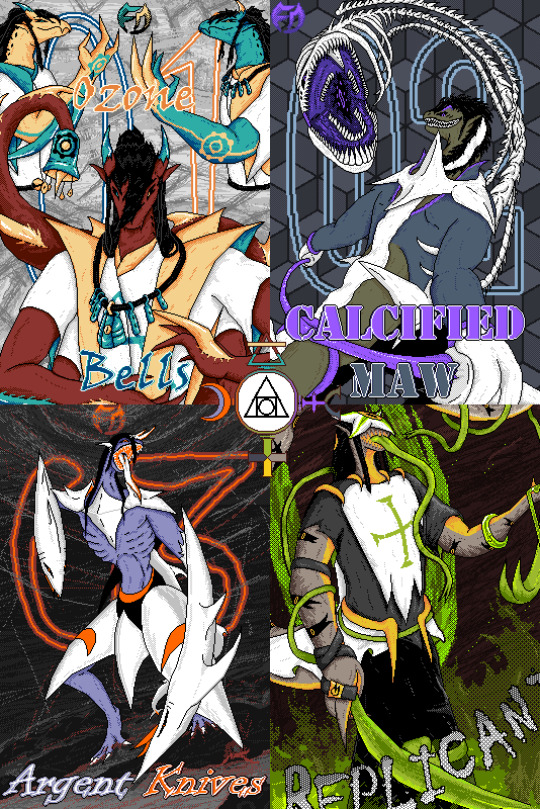
5 notes
·
View notes
Text
{Pocket Mirror}
(Video Game) Gameplay time: Long 7/22/2016
Creator: AstralShift and VisuStella
Publisher:KOMODO
RPG Horror Game,about a young girl stranded,in a realm of strange dreams and illusions along with even stranger characters,reminiscent of Alice in Wonderland ,with no recollection of her name or her purpose.She only has her pocket mirror in hand,only knowing deep in her heart that she must never let it go.
Honestly one of the most beautiful Rpg experiences I've had in terms of aesthetic.Coming from 2016 it reminds me a lot of the Vocaloid projects and songs at the time (Bad End Night as an example)with it's creepy/cute circus like aesthetic.It's honestly something quite nostalgic to me and I think this is why I was drawn to this game,with the Story book-like picture/cutscenes that differ a tiny bit from the classic Anime style the stills of the game show.
The soundtrack is also super memorable and beautifully fits each and every scene,character and chase or QTE sequence.I cannot begin to explain how much the remastered version put the emphasis in the music and it's new opening along with the gorgeous animation for it.It filled me with nostalgia despite never having played the game before.The character music themes are so unique and describe each and every one of them,along with their titles.
It's a game based on pure symbolism, both visually and story wise,although unfortunately it falls a bit short on the latter.I felt although the story isn't that hard to grasp,though complicated,it slightly drags on towards the end,to the point where you get slightly confused with the narrative and some scenes or dialogue that is not really much needed at the final look of the plot.Game play wise,it's a very dark (literally)game with a lot of replay-ability value which the very few save points it has,make it a bit exhausting to do even when it's one of the focal points in understanding the story.Especially with all the different endings.Some of the puzzles in the game are a bit ridiulously hard along with some QTE's that drain you back to back.
[THE REMASTERED]
About two to three months ago,the game got picked up by GoldenerTraum for a remaster,as the devs are working on the games (seemingly) prequel Little Goody Two Shoes.What I absolutely love about the remaster is its updated sound effects that match perfectly with the environment and characters,and how much more vibrant and intense the music overall is.
The pixel art for the game and it's animations have also gone through changes that make it look much more alive and colorful,smooth and succesfully enchances the chosen aesthetic it strives for.Menu,Save Menu and dialogue options have also been revamped beautifully along with now being able to have 20 save files,making the replay value much more worth it.I do however kind of miss the way the game looked before,being so dark it was a little tricky to navigate.
The new art is definetly a whole other style than the first stills and illustrations,except for the Story book like cutscenes mentioned before which I'm really happy about(there's even new art of this kind added in the game regarding a new ending!).Even though for me the new look has slightly lost the charm the old one had,the devs had the wonderful idea to be able to enable the old artwork in the settings for those who yearned for the nostalgia of it.
Plot wise, a new ending was added which further confuses things a little bit as now,a lot of the prestablished lore and symbolism becomes more confusing.I am hopeful however that the prequel will answer those questions thouroughly.
Overall,I think this is a game to dwelve in,if you enjoy the kind of aesthetic it strives for because trust me you will not be dissapointed.As for the plot,I did not feel like it brought anything that new and unheard of at the table,but it's immersive enough to keep you until the end.If you have the time and patience to finish and potentially replay a l o t of it from the begining then I'd suggest that you give it a try.
7.5/10
0 notes
Note
Have you ever given it much thought; the seemingly perpetual question and discussion people seem to have over whether or not VOCALOID is "dead" and the like? It's become somewhat of a loaded question and there's a lot of intersections between different aspects of it that people tend to mesh together, like mixing in the phrase, "VOCALOID is dead" with the software, or the song culture, or people "using it as a stepping stone." What are your thoughts as an observer?
Oh? I haven't really thought about whether VOCALOID is dead, to be honest. On the contrary, I think the community is very much alive. It’s an interesting question. I’ll cover a few topics here, so get ready. This could be long.
Topics
Is VOCALOID “dead”?
VOCALOID, the singing voice synthesizer
VOCALOID, a versatile voice
VOCALOID demographic and culture
--
Is VOCALOID “dead”?
When people hear the term VOCALOID, what comes to mind? Hatsune Miku and her iconic twintails? Kagamine Len and Rin? KAITO? MEIKO? Megurine Luka? Is that all there is? A set of anime-looking characters?
That’s only the peak of the iceberg that is the VOCALOID community.
At what point does a culture become “dead”? When no one talks about it or remembers it?
I think it depends on the social media platform. Sure, it might not seem very prominent on Tumblr (which seems to me more media fandom-based, with more of its users being fans but not many active creators), but on Twitter there’s actually a lot of active VOCALOID creators, or rather creators that focus on VOCALOID: producers, illustrators, video editors, sound engineers, etc, both in the Japanese and English community alike. Even the amount I follow is just a fraction of it. It might still be a small (Twitter) community compared to… let’s say fandoms of popular video games or cartoons, but they’re there, alright. It's small and very art-focused, and I say art as in visual, musical, and lyrical—aspects you’d usually find in music videos. And I find that tightly-knit community pretty comfortable as someone who enjoys short but concentrated forms of perhaps unconventional (?) multimedia storytelling (e.g. narrative animated music videos).
—
VOCALOID, the singing voice synthesizer
“Mixing in the phrase, ‘VOCALOID is dead’ with the software, or the song culture, or people ‘using it as a stepping stone’.”
That is a loaded question, and a good one. VOCALOID is so much more than just a singing voice synthesizer software, and even then there are other similar softwares like SynthV, UTAU, CeVio, etc. (Personally speaking I’m more familiar with SynthV since I’ve casually tried it out a few times. It’s quite complex but at the same time, the controls are what makes it powerful as a singing voice synthesizer. I think when people say VOCALOID, they don’t just mean the culture that comes with the VOCALOID software specifically, but any sort of vocal synth software (such as the ones I mentioned) applies too.
—
But anyway, the song culture, or rather the creative culture, specifically in terms of music. I mean, in the end, VOCALOID isn’t a genre of music, it’s a way to make music. And I’m no expert in musical subgenres or even genres, but I know this for sure: VOCALOID songs aren’t just pop songs with anime-style music videos.
VOCALOID and other similar softwares encourage creative freedom, since at their core is a set of singing voice synthesizers and voicebanks rather than one particular singer or idol, and thus producers aren't restricted to one single genre. It’s a tool—an instrument, even—for indie music producers, and I mean that in the best way possible.
—
VOCALOID, a versatile voice
This topic kind of came up when I was talking with a friend recently, but basically I mentioned that VOCALOID vocals can be pushed really far in songs depending on the genre, far beyond the default “cute” vocals fit for pop songs.
The high-pitched and perhaps sharp-sounding quality that typically comes to mind when one thinks about VOCALOID isn’t all that there is. It’s just as versatile as the human voice in expressing emotions, even if the technical aspect of tuning it is complicated.
And I mean, the idea of a singing voice synthesizer is pretty avant-grade, isn’t it? You’re controlling the very vocals of a virtual singer. I’ve mentioned I tried out SynthV a bit, but as I tried to play around and make a cover with it (it’s Neru’s “How To World Domination” if you wanna know which song), I became really conscious of how the human voice sings and how notes fluctuate for the first time. (Me studying phonetics in linguistics will only help in that understanding I believe.) Having knowledge on singing and the different musical genres definitely helps a VOCALOID producer or cover artist decide how they want the voicebank to sound.
In Utsu-P’s “I Thought I Was An Angel”, Miku sounds pretty soft or at least typical to how her voicebank is usually perceived but at around 3:18 she starts to metal-type screaming. I was really impressed when I first heard of it. (Note that lyrics talk about depression and self-deprecation.)
In one of his other songs, “Living Ghost is Alive”, V Flower also sounds powerful and eventually does metal screams (growling?) as well at 0:42 to 1:03 between lyrics. I feel like Flower’s voicebank works particularly well with heavier genres since she’s kind of similar-sounding to Len but with more texture… It’s really cool. (Note that video and lyrics has suicide and death inagery, and video contains flashibg lights.)
ippo.tsk is particularly good at tuning powerful and generally emotional vocals in SynthV (and previously VOCALOID with Len and Rin and CYBER DIVA) in my opinion. He’s the type that doesn’t stick to the perhaps cutesy default of the voicebank.
In ippo.tsk’s “rose-tinted bitter grudge” at around 2:03, he also makes Eleanor Forte do a growl which I believe is through one of the settings in SynthV’s parameter meter. (Note that the music video has sharp colours and flashing lights.)
Another example of powerful vocals is in their song “existing angel” at 2:08 — 2:55. The album version makes Len and Rin sound more crisp and clear without losing the power they had in the music video version. (Note that the lyrics talks about child abuse with regards to emotional/verbal abuse and the video has some flashing lights.)
—
VOCALOID, demographic and culture
Since VOCALOID is not a genre but rather a tool to make music, there’s naturally a wide array of genres when it comes to VOCALOID songs, in a similar way you can play a lot of genres on a guitar.
I am in no way an expert in the VOCALOID demographic and things like what genre is prominent in which era, but if you’re interested in that sort of topic, I’d recommend Oktavia / @symphonymermaid and Ye Sun / @RoboticReborn on Twitter.
Oktavia is an English cover artist who sings mostly obscure VOCALOID songs with amazing rhyme and rhythm in her translyrics and really goes in depth for translation and lyrical analysis for her lyrics. (I’ve talked about her cover of one of my favourite Neru songs, Datsugoku.) But at the same time, she talks about VOCALOID culture in terms of musical genres and obscure producers’ styles along with Project Sekai, the last of which I’m honestly not familiar with. (I can’t really put it in a more precise way than that personally, haha..) She even ran some popularity polls on which VOCALOID songs might be the most popular in certain “time periods”, which I found interesting. Nearly all the songs are the really popular ones that even I have heard of.
Ye Sun on the other hand, is a cosplayer and illustrator with a passion for VOCALOID and its culture as well. Most of his cosplay and illustration works are on Instagram but on Twitter, he sometimes talks about VOCALOID’s cultural significance in a much more sophisticated way than… anyone in the community that I’ve seen, in my opinion. It’s really interesting, some Tweets he’s made. He’s also really passionate about Ryuuseee’s character Bizu-kun in Neru’s song “SNOBBISM”.
But all in all, I’m not so well-versed in the idea of VOCALOID demographic and culture, so that’s all I can say here.
--
This ended up being really long, and it’s been sitting as a draft for some time, so I’ll just end this here. This has certainly been an interesting topic…
#dusk analysis#dusk answers#vocaloid#vocal synth#synth v#cevio#voice synth#miku#hatsune miku#utsu p#ippotsk#analysis#music#suicide#death#child abuse#emotional abuse#verbal abuse#depression#self-deprecation#(for the songs' trigger warnings)#Please know that I don't usually write long pieces like this (I think) haha
4 notes
·
View notes
Text
Some good papyrus angst comics/dubs i found!!
(If you want the comic, the have their links in description btw)
Okay, so "A Thorn In My Side" has to be the best one that portrays floweys abusive or manipulative sides to such a smiling flower. As well as the struggle of keeping your magic in check.. Or else.
If your looking for manipulative, scheming, dangerous flowey, or a the powerful papyrus trying to grasp his new extreme strength.. Or mabye you prefer intense scenes, with papyrus having to hide the truth from everyone in order to protect those he loves..?
Well this has got it all!
Dub link:
youtube
The dubber for Dustbelief sounds like the joker, which gives me not only physco crazy vibes but also the demo papyrus(a.k.a. the joker paps) and im all down for it.
This comic was also based off of an AO3, so id the dub doesn't satisfy you enough, you got your hands on some nice reading material to settle down on. (Or to unsettle if your looking for that haha)
Comic link:
Dub link:
youtube
Theres another comic on papyrus, called "Play Back Tale"
Linssins, the creator of the beautiful TV-head papyrus! Which, is flowey-papyrus-and the 6 human souls put together in the vocaloid's character from the song "ECHO" asthetic.
Short and wholesome comic.
Link to comic:
They also created "I KNOW THAT I KNOW NOTHING" comic or for short: IKTIKN
Its an amazingly illustrated black and white comic, that as quite the intrigue and mystery of papyrus and gaster mixed into a wonderful little donut.
I recommend it for those "papyrus is gaster" theorist or just fans looking for some secret behind the papyrus gloves...
Just like many of these, its not afraid to get dark, which is why the trigger warnings are there.
Link to comic:
!!!Now go on!!! Read your angst and enjoy these wonderful comics!
Feel free to suggest some more in the comments, as well as anything else you want to add to this!.
80 notes
·
View notes
Text
Review: Nendoroid 701 Snow Miku: Twinkle Snow Ver.
There are some Nendo I buy because they have parts I want, some I buy because I’m a fan of the character they’re based on and there are some I buy because they just are too adourable.
Nendoroid Snow Miku: Twinkle Snow Ver. belongs to the last category and she’s still my all time fave Nendo for beauty, no one looking as adourable as her in my books.

Expensive... as almost all the Snow Miku, but if there’s a Snow Miku I don’t regret buying in the slightest (and I love my other Snow Miku) it’s her.
But, in case you’re not familiar with the term, why is she called a “SNOW MKU” and not just ‘Hatsune Miku’?
During "Sapporo Snow Festival 2010" a snow sculpture of 'Hatsune Miku,' was created. From that moment on "SNOW MIKU" became one of the main characters of Hokkaido winter with her own "SNOW MIKU" festival, held each year, her figure being turned into a different Nendo each year.
From 2012 the costume design for "SNOW MIKU" is selected in an online competition on different themes every year.
Nendoroid Snow Miku: Twinkle Snow Ver. is the winner of the 2017 competition whose theme was 'Stars and Constellations of the Winter Hokkaido'.
You can also see a rabbit near Miku, that’s Rabbit Yukine, her pet, a lepus timidus ainu (a kind of mountain hare), chosen as her pet among the animals in winter of Hokkaido, from among the public in 2014 (although in 2013 Snow Miku already had a snow bunny with herself).
Well, now let’s give a look to the illustration made by illustrator Nishina that inspired her.

You might notice Yukine looks different because he’s actually based on an illustration made by another illustrator LF.
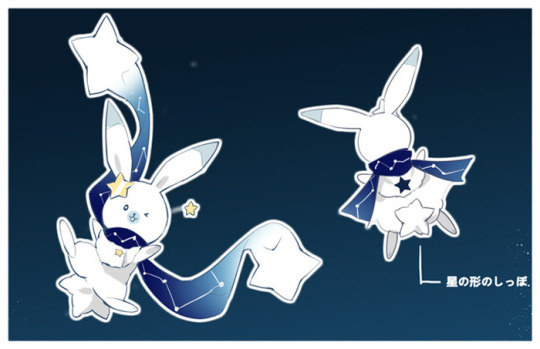
I’ll let you see the official art for her as well because it’s worth it.
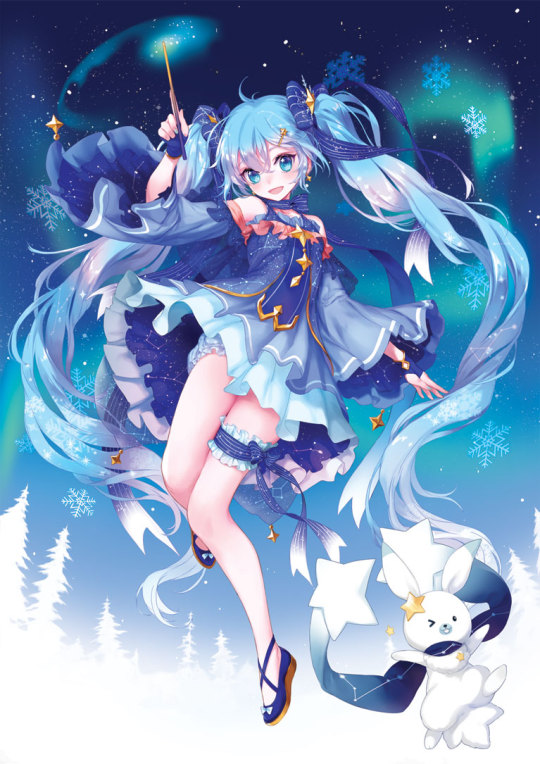
And now let’s dig into how this Nendo is.
Snow Miku: Twinkle Snow Ver.’s package is a special package created just for her. The package is in a pristine white (though due to poor illumination it might not seem so) with images of her behind it and on its sides. Do yourself a really HUGE favour and avoid buying bootlegs of this Nendo. She might be expensive but her beauty is worth it.
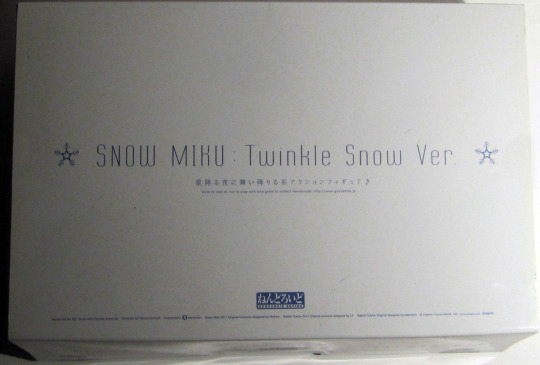
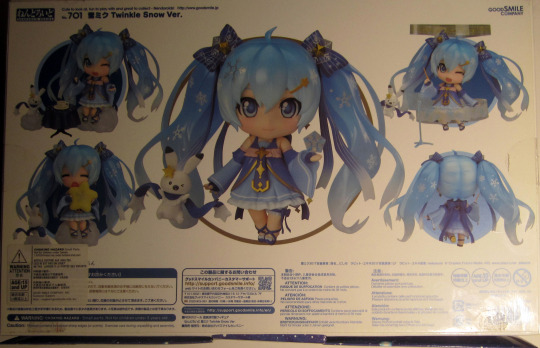


If you raise the bottom part you get this:

a beautiful pop up snow and star filled scenery just for her which can work as a stage for her to sing her songs.
If you instead open the right side of the box you are first shown the draw that inspired her...

... then you can pull her blister pack out, with Snow Miku in all her beauty wrapped in protective plastic.

And here she’s unwrapped.
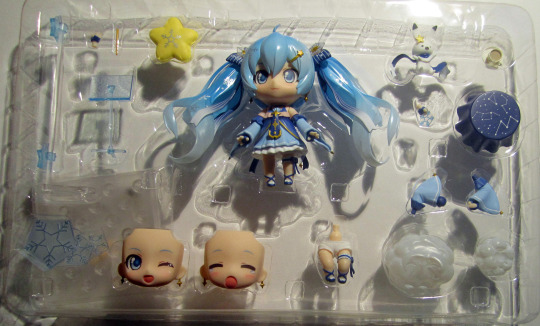
As you can see she comes with many interesting accessories (and her stand is attached below the blister pack).
But let’s go with order.
The less insteresting part first, her stand and Yukine’s.

Yukine’s stand and brace are the standards for pets and companions.
In the past I talked of how Nendoroid Mami Tomoe Maiko ver. has the same stand and brace for Bebe.
The brace is not the standard one but the one used for female Nendoroids with hair floating on their backs. I talked about it, talking about Nendoroid Asirpa. I don’t know why they gave her this brace as her long hair are tied into twintails at the sides of her head and therefore don’t fall on her back.
Whatever, maybe it support better her weight as due to those twintails she IS heavier than many other Nendo.
The base is a square one but huge compared to the standard base, likely that big to host the overmentioned twintails as well.
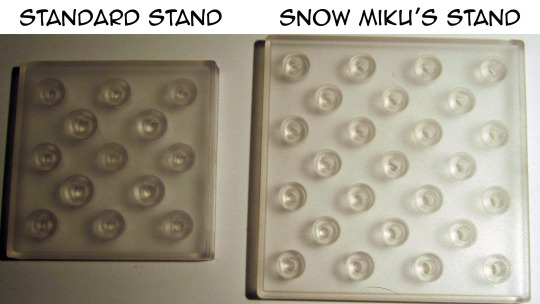
Of course we’ve instructions in English and Japanese.

And now let’s look at all of Snow Miku’s disassembled parts!
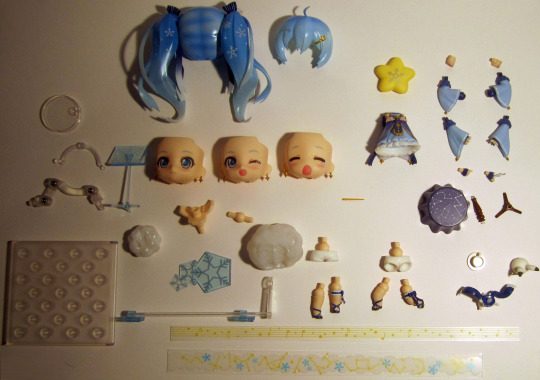
We’ll start with the legs.
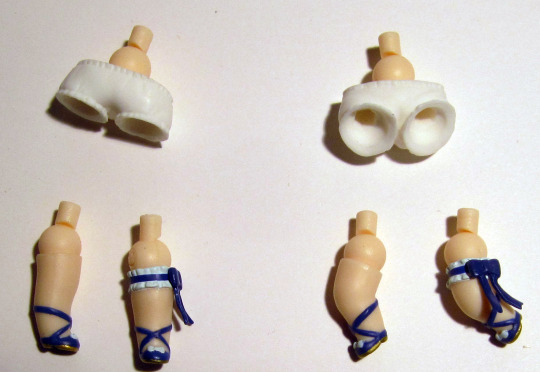

Snow Miku comes with some delicious blue ballerinas with the sole in gold, a single lovely garter wrapped in an equally lovely blue string on her left leg and adourably cute poofy underwear.
Yes, she has two set of underwears because if you use the one on the right with the bent legs you can have her sitting down.

It’s also worth to note how the peg connecting her lower body to her chest is a mobile one, allowing her more mobility in the waist area compared to many other Nendo.
I love how they carefully depicted all the folds of te gaiter and of her underwears.
Arms now.

We’ve 4 arms, 2 right ones and 2 left ones, but the upper part can be removed, allowing for even more posing.
The long sleeves in a pale blue with parts of dark blue and a white line with a lovely star attached at the end are incredibly cute and again the folds are well depicted.
The hands, 6, are covered by blue fingerless gloves. In addition to the standard open and closed hands we’ve hands to hold a beautiful snow star crystal...

and one to hold the baton to direct the orchestra as she sings.


Apparently the star crystal can’t be removed but the baton can. It’s very tiny and of a beautiful gold colour.
Another accessory she can hold is her cute star shaped pillow.


This one isn’t of solid plastic but of a soft, squishy material. I love it.
And now let’s give a look at her body.
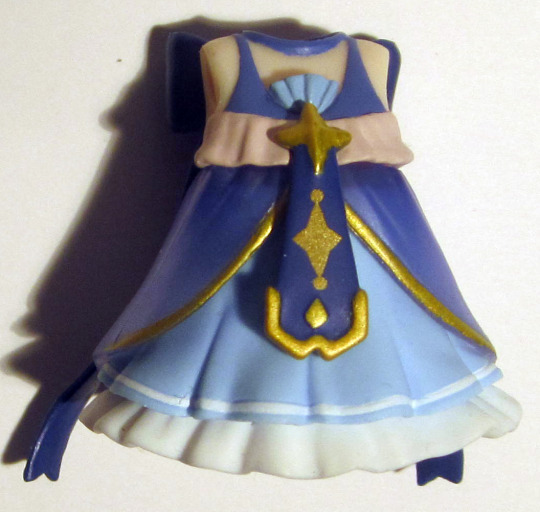
Her dress is a mix of blue, pale blue, gold and white. It’s elegant and lovely with all those beautiful fonds and details and the colours mixing so well.

Behind there’s a ribbon and it becomes almost translucent, as if it was a cape with, again, two lovely little stars.
Really, the care for details is amazing in this one.
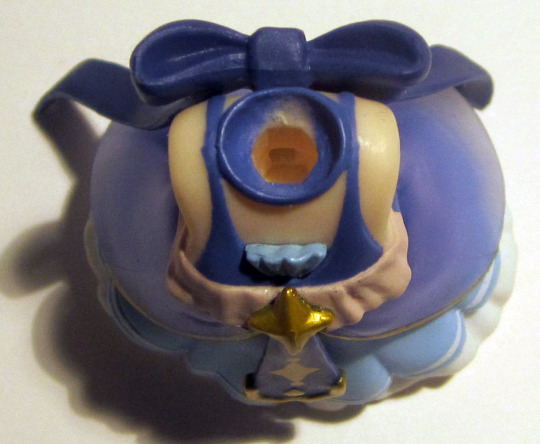
Here, admire it with all its parts.

Faceplates now!

They’re three but each expression is lovely. For start they all have adourable gold star shaped earrings.
Stars are also shining in Miku’s eyes, both as light in her eyes but also in her wink.
The fist expression have a cute, almost kitty like smile, the second is filled with cheer and the third is an adourable sleepy expression with Miku yawning with tears in her eyes, fitting for the nocturnal theme of the stars and the fact she comes with a pillow.
The slight blush, the tiny white dots on her cheecks that lighten her expression, they all increase her charm.
And now something else I also adoure about her.
Her hair.

Instead than Miku’s usual green hair, Snow Miku have azure hair, fading into white, adourned with star snowflakes and tied into two beautifully long and detailed twintails, not her usual straight twintails but poofy twintails with strands fluttering away from them and the tips curling. Her frontal hair are hold in place by a gold starshaped pin, also beautiful and do we want to talk of the ribbon tying her twintails?

Long, blue but they also fading in white, adourned with a penragram, gold star and snow crystals, their tails falling so beautifully along Miku’s hair.
Ah, they’re a work of art!
(On a sidenote the tails of the ribbons are attached to the twintails, but the ribbons are actually a separate piece which is inserted with a peg in Muku’s head and therefore can’t be used on other Nendo. I was afraid to remove it in fear of breaking it so I’ve never tried doing it but I guess it can be done. I just wouldn’t recommend it as it would be a pity to break it.)
Anyway I ABSOLUTELY love her hair.
And, of course, as in many Mikus, it’s long enough to allow her to stand without a stand, supported by her hair only.

She’s such a cutie, isn’t she?
And now two words on Yukine.
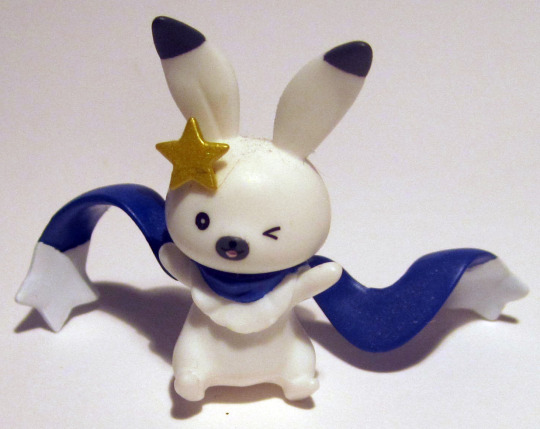
Yukine is really, really cure, with that blue scarf with stars at the end and that star on his head. The winking expression makes Yukine look mischievous and a perfect pet for Miku.
Yukine’s head can be removed, she means one can also turn it in different directions... but apart for it there’s nothing else that can be moved.

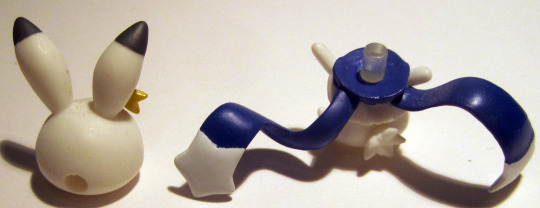
In case you were wondering yes, Yukine has a tail, which in this version seems to be star shaped (Yukine’s tail changes shape according to the theme).
Accessories now as Snow Miku comes with a bunch of them.
For start there’s a lovely table with a starry tablecloth.


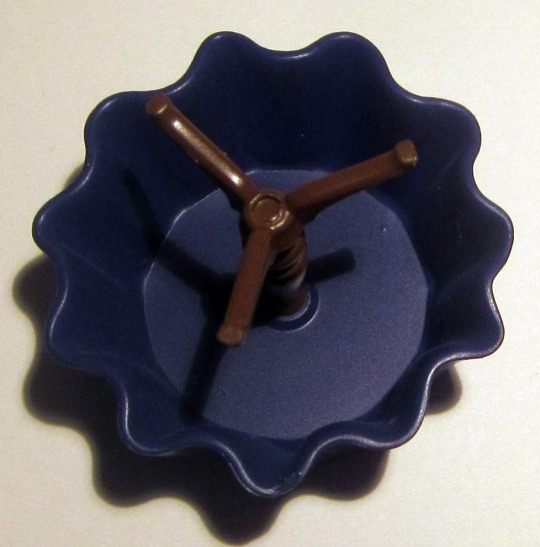
It’s really cute although it reminds me of a fortuneteller table.
You can rest on it this lovely tea cup with a cute snow crystal on it.


Although it’s meant to be drank Miku doesn’t come with a hand to hold it so you can just rest it on the table. Also I couldn’t remove it from the plate. Maybe it’s possible and mine just is a little hard but I didn’t want to break it.
In order to sit around the table Yukine and Miku can use two very special chairs, shaped as snow clouds!

As you can see there’s a concavity for Miku and Yukine’s bodies so as to hold them in place. The below surface is flat so you can rest them on each surface but you can’t connect them to the stand.

Miku and Yukine though can sit still on them without needing stands so maybe that’s on purpose.
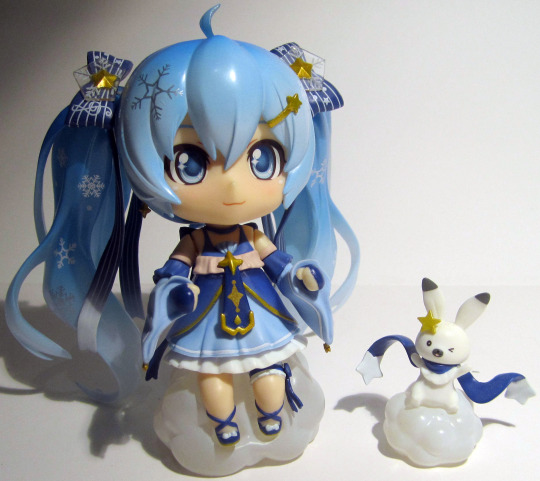
We continue with this snow crystal part for Miku to walk on.
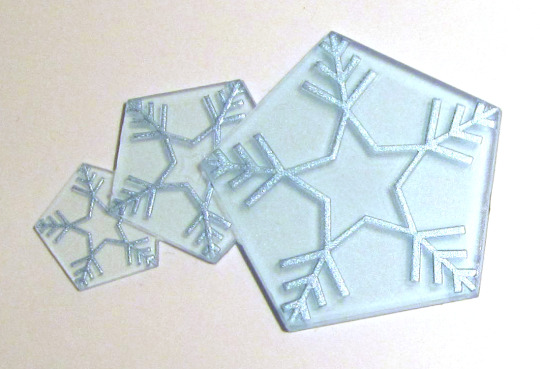
In trasparent blue plastic, it’s beautiful and gives me a Frozen feeling, making me think of when Elsa runs away from her palace on a bridge she created with snow and ice.
We continue with an icy music stand to use with her baton so she can direct her starry orchestra.
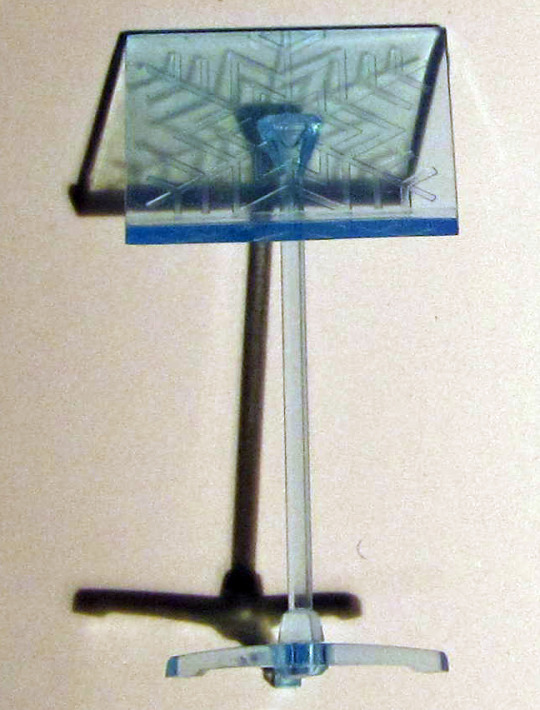
It’s really cute.
If I’ve to be honest the only thing I’m not too fond of is the ‘musical effect’.

Those two transparent plastic stripes with snow, stars and music themes are to be attached to this starry piece, each strip should slid into the space in between each star.


The ring at the bottom (in the pic placed at the right so you won’t have a too long image) is meant to be inserted in the brace that support Miku like this.

The overall effect doesn’t really impress me much...



...but of course it might be just me. Also as the stripes aren’t that soft they weren’t really happy to be bend into circles. Maybe I overworry but I was afraid they would snap the stars holding them.
Now… poses.
They’re all adourable and easy to get. Maybe the one who’s a little more of a nuisance is the one with the star and music effect above exactly due to them not being that comfortable to latch around Miku. But maybe it’s just me.







Would anyone who’s not fan of Vocaloids or of Hatsune Miku, want to buy her?
Well, as said above I’m TOTALLY partial to her. She’s adourable, extremely cute and I just can’t resist her.
I think she’s totally worth being bought, her spare parts are also very nice, the sitting part as far as I’m involved is always a plus, she comes with cute furniture and her yawning expression is so sweet and her hair and dress are beautiful and... well I love her.
She’s expensive, true, but for me she’s totally worth it.
10 notes
·
View notes
Photo

Artist spotlight: Keuwibird!
✿ Ko-fi ✿ Tumblr ✿ Instagram
Header source: [X]
Introduce yourself Hi! You can call me Keuwi or Kai, and i'm a digital artist from the Philippines. I enjoy doing art, as well as baking, playing the ukulele, and staying up at ungodly hours in the morning watching youtube. I'm in a lot of fandoms; many of them pretty obscure but you'll know what i'm currently into by the reblogs on my tumblr haha. When did you start drawing? Are you a digital or traditional artist? I've been drawing traditionally ever since I was little, but I started going digital at around 2014 or 2015 and have been mostly using the digital medium ever since. Do you use any traditional mediums? If so, which are your favorites? Even though I mostly post digital art, I still like to do a few traditional pieces every now and then. If I do, I usually stick to pens and pencils.
Why do you prefer traditional over digital? (or viceversa) I like doing digital art mostly because I feel like I can get much cleaner pieces than when I go traditional. I also find it easier to color my art digitally. What do you think is the most challenging part about being a traditional/digital artist? Based on my personal experience, there's just some things in traditional art that you can't duplicate with digital art, and vice versa as well. I actually find it easier to sketch and line traditionally, whereas it's so much faster and easier to color and erase mistakes in digital art. There's always going to be pros and cons, and certain qualities in one medium that cannot be found in the other. The challenge for me would be to find a middle ground or an alternative for those missing qualities. What inspires your pieces? A lot of my pieces are inspired by the fandoms that i'm currently interested in, as well as my own original stories and characters.

image source: [X] Explain your "everyday" drawing process When I get an idea for an art piece I want to do, I first sketch something really small and simple on paper, then I make another sketch digitally on my phone. If it's just a quick drawing, I keep using my phone, but I switch to my laptop if it turns out to be more detailed. I usually go through two sketches, followed by lineart, flat colors, and shading. Do you have an artist you admire (or more than one)?
There's so many artists that I draw inspiration from! One artist in particular that i've always admired is Meyoco. I just love her pastel color palettes and the way she draws details. I also especially love her floral and wave designs. Is there an artwork you are most proud of? Why? I don't think I have one single artwork that i'm most proud of, mostly because whenever I make a new illustration I feel like there's always some aspects I could improve on. Though I do feel accomplished whenever I learn a new technique.
Do you listen to music (or tv shows/films/anything else) when drawing? I usually do listen to something when I draw to fill the silence, but my choices are honestly just so random every time that I don't know where to start! I mostly listen to various music genres (including but not limited to vocaloid, lo-fi, etc.) but I also listen to podcasts, livestreams, and youtube videos in general.

image source: [X] What makes art interesting for you? I personally like art that has vibrant color palettes and looks more cartoon-y or anime-like. I also really like looking at detailed backgrounds. What do you do when art block strikes? Most of the time, I go to either tumblr, instagram, or youtube to look at art or fandom stuff. If not, I just take out my sketchbook and make random doodles. What’s the most valuable art advice you’ve ever received?
One of the things that i've learned over the years is to not be afraid to look at references when you draw. Drawing from references is a really good way of practicing to draw something that you're not that used to drawing yet, and afterwards you can further experiment and apply your own "flair" to that thing once you have gotten more familiar.
12 notes
·
View notes
Note
Who's your favorite vocaloid?
IN ORDER FROM MOST FAVE TO LEAST FAVES ((OF THE FAVES bc i dont know ALL the vocaloids theres so m a n y)) BASED P MUCH ENTIRELY ON MY FAVE SONGS + THEIR DESIGN AESTHETICS
1. MIKU (( QUEEN absolutely no vocaloid can fully encompass creepy AND cute and P MUCH EVERY GENRE OF MUSIC quite like miku (at least imo!), shes aesthetically perf and creatives can make her voice do p much anything YOU WANT HER TO SING A CUTE POP SONG?? HEAVY METAL SCREAM?? RAP?? POLKA?? JAPANESE?? ENGLISH?? RUSSIAN?? U WANT HER TO SING DESPACITO (pls look it up) HECK YEAH MIKU IS HERE FOR U BC SHE IS QUEEN 👏 AND ‘TWO FACED LOVERS’ IS STILL MY FAVE VOCALOID SONG despite me jumping between other songs and loid faves haha aaa im gonna learn the dance to it one day *shakes fist* ))

2. GUMI (( gOD my fave vocaloid song for ages was ECHO and it still gives me chills today (plus inspired the story and characterization for two of my ocs!!) aND THEN “AGAIN” INSPIRED THE COMIC FOR ANGST WEEK ON MY MAJIMA BLOG HAHA and lets be real who WASNT inspired aesthetically and just in general by ‘Matryoshka’ ??? ALSO ‘MONSTER’?? ‘MACHINE GUN’?? ABSOLUTE BOPS!!! GUMI GOT THE GOODS!!!! ))

3. TETO (( I KNOW SHES AN UTALOID BUT I LOVE HER AND IM BEGGING YOU ALL TO LISTEN TO TANJIRO’S TETO COVERS the whole playlist is called “Teto Justice” and honestly i dont think anyone knows how to tune a loid as good as them!! ))

4. RIN (( meltdown is a dAMN GOOD S ON G also “Alluring Secret” fuckin chANGED THE GAME OK ive been wanting to do a jyushihomu vers of that forever kfjgh ITS SO INSPIRING!!! also from ‘Alluring Secret’ to ‘Summer Idol’ i love how gay she is for miku fkkjgkhj AND LETS NOT FORGET THE EVIL SERIES ))
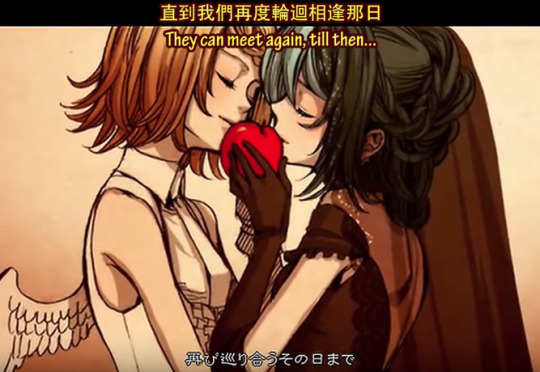
5. LEN (( AGAIN, EVIL SERIES also pls look up the “LEN GROWL” cover of ghost rule is sO SO GO O D aND ‘BRING IT ON’ FUCKIN SLAPS ))
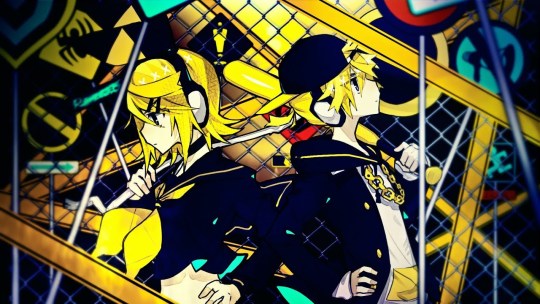
6. LUKA (( I ADORE LUKA’S VOICE AND ‘LUKA LUKA NIGHT FEVER’ WAS ONE OF THE FIRST VOCALOID SONGS I EVER HEARD GHGH shes so damn prETTY I RLLY LOVE HER DESIGN and the only reason shes not higher up is bc her voice is super chill and makes me relaxed and i tend to listen to vocaloid stuff more when i need to get hype (like if i have cleaning or work i need to be rlly awake and motivated to do haha) bUT I STILL LOVE HER ))

7. NERU (( ’STOP NAGGING ME’ WAS STUCK IN MY HEAD FOR SO L O NG sO SHE DESERVES TO BE ON THIS LIST also i recently found out that shes the “anti troll/flame vocaloid” and was literally created out of spite by a vocaloid fan to tease mean trolls aND THEN THE ARTIST (Smith Hioka) MADE A DEAL W CRYPTON AND SHE BECAME AN OFFICIAL VOCALOID CRIES ))

THIS GOT LONGER THAN I MEANT IT TO GHGHGtbh i got into voca/utaloids really late like literally last year HAHAi didnt really like the autotune-y voices at first but then i heard ECHO for the first time and it really made me wake up and realize just how much work goes into each song and all the art work/animations/edits ETC
ITS LIKE EACH SONG IS AN EXPLOSION OF SO MUCH ARTIST EFFORT AND I RLLY STARTED TO FULLY APPRECIATE THEM!! MUSIC PRODUCERS/TUNERS/WRITERS/ANIMATORS/ILLUSTRATORS AND OFTEN ITS JUST ONE PERSON DOING ALL THAT and then came genuine love for the music! ALSO THE AESTHETICS ARE JUST RLLY GOOD HAHA
i always loved miku’s design even before i was a fan of her voice! AND THE RIGHT TUNER MAKES A W O R L D OF DIFFERENCE if your first vocaloid song exposure was a badly tuned miku im so sorry
i feel really lucky that by the time i became part of the fandom there were sO MANY really skilled music producers working on vocaloid songs i rarely encounter a badly tuned song nowadays!
#vocaloids#utaloids#hatsune miku#megpoid gumi#kasane teto#kagamine rin#kagamine len#megurine luka#akita neru#miku#gumi#teto#rin#len#luka#miku hatsune#gumi megpoid#teto kasane#rin kagamine#len kagamine#vocaloid#utaloid#cmoontoon shoosh#moonime#avenire
43 notes
·
View notes
Text
Is The Caligula Effect: Overdose Worth Your Time?
I initially wrote this review for an episode of The Pixcelation Show over on my channel, which you can visit by clicking HERE. If that seems like something you’d enjoy, please scroll to the bottom to find the finished video. Thanks!
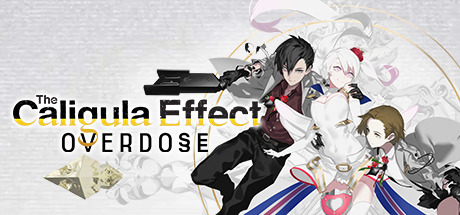
In the spring of 2018, an anime by the name of Caligula aired. No; before you ask, it’s not at all connected with the incestuous third emperor of Rome, nor is it connected with the 1979 film about the incestuous third emperor of Rome, but rather, it’s reportedly named after ‘the guilt and excitement that comes with doing something that you shouldn’t do.’ It didn’t really do too much for the anime community at large, only receiving a 6.18 on MyAnimeList as of writing. I remember thinking the series was unnecessarily complicated, and, it being deeply rooted in psychology, it tended to play armchair psychologist to an annoying degree, but it was serviceable, at least.
It wasn’t long after I started the series that I discovered it was based on a game released on the PlayStation Vita called The Caligula Effect, but I would’ve never known about it because there was next to no marketing for it here in the west. I suppose such is the fate of a JRPG on one of the most, if not the most, underappreciated consoles in history.
Welcome to the Pixcelation Show; the only series on YouTube to tackle the questions on everyone’s mind, such as ‘do artificially intelligent idols dream of electric sheep?’ I’m pixcelation, and in today’s episode we’re not gonna be discussing the Caligula anime, nor are we gonna be talking about the original game on the PS Vita. No — in today’s episode, we’ll be talking all about the recently released remaster on PS4, Switch and PC, entitled The Caligula Effect: Overdose. In order to be completely up-front with everyone, I feel obligated to disclose that I was given a code for the PS4 version by NIS America, who published the game in the west.
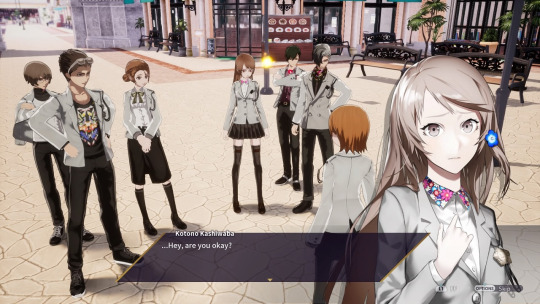
Imagine, for a moment, that the vocaloid Hatsune Miku gained sentience, and because of songs such as The Disappearance of Hatsune Miku, she comes to the foregone conclusion that we’re all practically suicidal and that being in the real world is what made us this way. So, she does what any rational, sentient AI would, and traps us in the matrix. In the world of The Caligula Effect, their Miku, an AI known as μ, believes she can provide humanity with a happier existence within the artificial world she’s created, called Mobius.
In The Caligula Effect: Overdose, you play as an unnamed protagonist, one of the people invited by μ to live within the simulation. It doesn’t take long before they’re able to see the rift, at which point they join a group of rebels fighting back against μ and her Ostinato Musicians, all of whom desire to keep everyone blind, deaf and dumb to the truth about their world. As you come face-to-face with each of the Ostinato Musicians, you begin to unravel the truth behind the truth, and you’ll be forced to take sides in the battle for the future of both Mobius and the real world.
In my opinion, while the story isn’t necessarily anything revolutionary, the characters drive it home with relatable arcs and … well … character. In the Go-Home Club, as well as the Ostinato Musicians, there are incredibly memorable characters that really twist your arm when it comes to picking the ending you’d prefer. In both groups, there are characters that are foils for characters on the opposing side. For example; Kotono, Mifue and Shogo in the Go-Home Club directly oppose Mirei, Sweet-P and Thorn respectively, in both their actions and character arcs. I really liked how they handled that, as it helps to illustrate the idea that, while the Musicians are the enemy, they’re also only human, and as such, while you may want to return to the real world, each of them has their own compelling motive for remaining within Mobius.
In thinking about each respective arc, one thing that I wasn’t the biggest fan of would be how the writers handled certain social issues through the characters. I’ll provide an example; in one of the early arcs, it’s revealed that one of the Musicians is transgender in the real world, and as a result they’re often the butt of everyone’s jokes just because they’re one of the ‘bad guys.’ I found that, when I was given the option to join the Musicians and learn more about this person, they actually seemed to develop into more than just a stereotype, but players who didn’t choose to become a double agent like I did would never know that, and therefore think of them as a joke. The same can be said of another character, who has developed a hatred of overweight people, and as such the game tends to play said people as stereotypes that only exist to stuff their face. I applaud the game for tackling heavy issues such as body dysmorphia and eating disorders, but I could have gone for less of the victims of these conditions being played for laughs.
In-universe, the cannon fodder enemies, called ‘digiheads,’ are created because:
they aren’t aware that Mobius is a simulation, and
they listen to μ’s songs way too much.
I could see people going insane and attacking each other after listening to the same song in a twenty-four hour loop in this reality, especially since each and every stage in the game has its own unique track … that is played … nonstop. I almost lost my mind at first, but thankfully, I either got used to it, or I’m actually a digihead and I’m trying to pull you into Mobius. I really did enjoy the character songs, though; they’re all produced by well-known artists such as DECO*27, Pinocchio-P, 40mP and OSTER Project, among many others, and they add a whole new layer of depth to these characters who only appear a minimum of times in the main story. I kind of wish the Go-Home Club also had character songs, but that might not make too much sense in the story, so I guess that’s something I’ll have to accept.
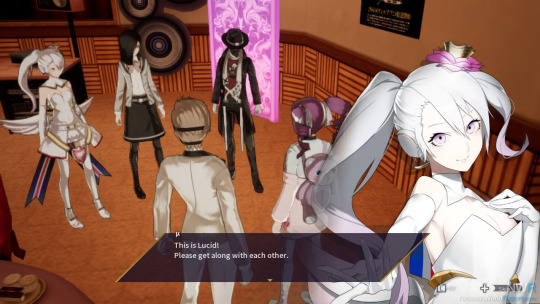
I have to admit, I had every intention of quitting the game and writing that it was just as good as the anime adaptation, but then I had a change of heart. I decided to give it another shot, and it was then that I discovered there was an option to join the Musicians, as I mentioned earlier. I can’t really tell you why, but playing as Lucid, the musician version of the protagonist, is very fun. Sure — the game doesn’t really change in any meaningful ways until the final battle, but between the character designs of Lucid and the other Musicians, and the fact that you can learn so much more about your supposed enemies, this addition makes that final decision weigh a lot more than it would’ve otherwise.
I won’t sugar-coat it; as much as I adore this game and its aesthetic, The Caligula Effect: Overdose is so desperate to be the next Persona that it’s practically salivating. Think about it: it’s a third-person, dungeon crawling RPG where you control students fighting back against forced they don’t understand in order to solve a prevalent mystery, and their adventures are rooted in psychological themes and motifs. There’s a social system where you can create bonds with not only your teammates, but also with all five-hundred-and-twenty-four students in the school, and as you deepen said bonds, you can help them overcome the trauma that keeps them in Mobius. Its battle system is reliant on powers your characters can only use after they’ve confronted their true selves and accepted that they want to return to reality. It’s probably not a coincidence; the writer who penned the game was Tadashi Satomi, who worked on the first three games in the Persona franchise, so that most likely explains the unnerving similarities, but I’d argue this game takes the social aspect a bit farther than its more shiny cousins.
I’ll give the social system credit where it’s due; it’s the most simple and most complex of its kind. As I said, there are five-hundred-and-twenty-four students in the school, and you’re able to not only become friends with all of them, but you can invite them into your party and fight with them in the main game if you … dislike the main cast, for some reason. It seems a bit overloaded, because the developers seem to expect the player to max out their bonds with every student in the game, but … that’s just too much to ask when some of the students seem to appear based on a random number generator. It’s almost like they wanted to incorporate a system that’d keep players engaged after the main story had concluded, but it ended up manifesting as a chore to work through. I dunno about y’all, but, when I see that there’s over five-hundred students, and I’m expected to resolve every one of their traumas, that’s where I check out. In Persona 3, 4 and 5, there were actual incentives to maxing out social links — not only did it increase your stats, but there were also less than five-hundred to complete, and they all had unique dialogue options that helped the experience feel less like a chore. As a result, you looked forward to the next chapter of each character. In this game, I’m aware that fully completing bonds does seem to improve your stats, but when the dialogue is recycled so often that I skipped a lot of it, there’s no reason for me to care about anything they’re saying. I think this concept is actually really solid, but if it’s filled to the brim with mediocrity, it’s not gonna realize its full potential. I’d love to see a game utilize the interconnected nature of its NPC cast in the same way that this game did, except there’d be more reason to go along with it.

I really have to give the game props for its intuitive battle system, as it turns the concept of being ready for anything on its head. As you engage your target, you select your given attack as you might in any ordinary JRPG, but you’re then given a chance to see what your attacks would do ahead of time, as well as adjust the timing of said attacks. It seems a tad bit like cheating the system since you can see what moves your enemy will make, and cater your turn accordingly. I must admit, however, that as unique as this prediction system is, I found myself caring about it less and less, instead opting to use the same moves over and over again. It may sound cocky to say that I knew the attacks would land, but it’s a disturbingly accurate segue to my next point.
I started my save file on ‘normal’ difficulty, but the longer I played, the more it felt like the easiest difficulty there was. I was grinding like a madman, sure, but there’s no reason the bosses of each chapter should’ve been taken out like a snap from the Infinity Gauntlet. I just expected more of a challenge from normal difficulty, that is to say, any challenge whatsoever. I thought it might pick up towards the endgame, but even the final boss was a breeze to get through. I say all this, but I know that if they were to patch in a more difficult mode like they did with Kingdom Hearts III, I would probably cry, so … I’ll leave it at that.
Here are some things you might want to keep in mind before playing The Caligula Effect: Overdose:
+ If you haven’t played The Caligula Effect, there is quite a lot added to Overdose that was not present in the original. For example, characters Eiji Biwasaka, Ayana Amamoto, Stork and Kuchinashi are all new additions with entirely new dungeons, but they’re integrated really well into the story and don’t feel like additions.
+ If you’re looking to get that sweet, sweet platinum trophy, make sure you keep up with all the character scenarios on both the Go-Home Club’s side and the Ostinato Musicians’ side. It appears that Eiji’s scenario is critically linked with Kuchinashi’s, and if you don’t complete Eiji’s by the time the story takes you to Landmark Tower, PEOPLE WILL STRAIGHT UP DIE, and you’ll be unable to complete the deceased character’s scenarios.
+ If you choose to accept Thorn’s offer to become one of the Musicians, DON’T FEEL BAD. It may start to weigh on your conscience as you betray your friends, but you’re not on the bad route by handing out with the Musicians. In fact, you’re required to max out all of the character scenarios in order to get the true ending. PLUS, if you refuse to join the Musicians, you’ll miss out on a bunch of adorkable moments involving μ, and you won’t want to miss those!
+ If you want to get the bad end, you don’t need to max anyone out — just accept Thorn’s invitation, then at the final battle, choose to stay in Mobius instead of going home, and … well, I’ll let you see for yourself.
+ I’ve heard whispers that it might not be possible to max out Ayana’s scenario unless you’re playing as a female, because of her androphobia. If you’re having issues with Ayana, maybe try again in a second playthrough.
+ If you’d like to explore Mobius a second time, there’s a New Game + option that’ll allow you to increase the enemy level en masse if you’re wanting a challenge, as well as carry over your levels and NPC bonds. It won’t, however, carry over your progress on character scenarios. You can also pick the female protagonist in a New Game +, which helps if you’d like to get that plat.
+ SAVE. SAVE. SAVE. In a game like this, you want to save every chance you get, as when your party dies, it’s lights out. There is NO autosave, NO continues. It takes you right back to the title screen, so be wary of that.

Is The Caligula Effect: Overdose a perfect game? No — not at all. BUT, is it fun? Yes. It’s a unique JRPG that uses the tried and true tropes found in many others of its kind, but at the same time, experiments with other elements of its presentation to create a memorable experience. I may not be motivated to complete the social element of the game, but I struggle to find fault in other areas, such as the character designs, the music and the overall aesthetic.
It deals with some very serious topics, such as body image issues, gender dysphoria or transgenderism, suicide and androphobia, among others, and while at times it can feel as if its poking fun at these issues, for the most part it does handle them with respect, and ultimately shows that these very human characters deal with things that humans too, often struggle with.
If you’re anything like me, you might be tempted to give up on it after the second stage and call it a day, but I implore you to be patient, as the game hits its stride in and after the third dungeon. If I had given up on it like I planned, let’s just say this review would be quite different.
youtube
#the caligula effect#the caligula effect overdose#caligula#anime#gaming#ps4#nis america#nisa#nippon ichi
5 notes
·
View notes
Text
What Vocaloid brings to the culture (1711 words)
Vocaloid is a voice synthesising software that creates sound based on the human voice. Nowadays, it is very popular with mainly young people worldwide. The oldest Vocaloid released was Leon and Lola, from Zero-G - a company in the United Kingdom, and the first Japanese Vocaloid was Meiko, from Crypton Future Media, developed by Yamaha, which first announced the development of Vocaloid. They were all released back in 2004, however, they became famous in 2007, when Hatsune Miku got released. Hatsune Miku appeared in Nico Nico Douga, a Japanese video streaming website, where users posted Vocaloid songs using her. On 7th December 2007, a song called “Melt” by ryo(supercell) was released(Figure 1), and 5 days later, a cover video of Melt by halyosy was out(2007), which let the song become very popular. They monopolised the top ranking of Nico Nico Douga, and people called this phenomenon “Melt Shock”.

Figure 1: “Melt” (119, 2007)
In Nico Nico Douga, users who posted cover videos of Vocaloid songs named their video “I tried to sing(歌ってみた)” which made the users feel more casual to post videos that related to the song. Eventually, “tried to sing” derived “tried to dance(踊ってみた)”, “tried to draw(描いてみた)” “tried to play(instrument)(弾いてみた)” etc, which gave more chances to creative people to perform what they enjoy with their favourite music and this led to the songs becoming more known. There is also a website called “Piapro” which supports this. "Piapro" provides a "place of creation" for creators dispersed on the Internet to post each other's favourite content (music, lyrics, illustrations, etc.) and collaborate to create new content. The illustration used in “Melt” was first posted in Piapro, which led to ryo, the producer and 119, the illustrator to form a new group “supercell”, which is famous for the anime song “A story you don’t know (Kimi no shiranai monogatari/君の知らない物語)” meaning, ending theme song to the 2009 Bakemonogatari anime series.
Out of all Vocaloid song producers in Nico Nico Douga, ryo was the first to release their own music which wasn’t using Vocaloid. As similar examples, Hachi released songs such as “Matryoshka”, “Sand Planet” is now working under his real name Kenshi Yonezu and has released many hit songs such as “Lemon” which was played 700 million times on Youtube, and he became a famous pop star in Japan which led some people not knowing he used to create Vocaloid songs. Another example would be Ayase, creator of “Last Resort”, “Ghost City Tokyo” has formed a group “YOASOBI” which is very popular with young people and is famous for “Into The Night(Yoru ni Kakeru/夜に駆ける)” where the Japanese version is played more than 100 million times, and there is also an English version which is played 7 million times. Kenshi Yonezu and ryo don’t create Vocaloid songs anymore, but even though it's rare Ayase still creates Vocaloid songs after being famous for YOASOBI, such as “Cinema”.
I have given examples of songwriters who stopped using Vocaloid for their music, however, there are still many users who use Vocaloid. A songwriter, syudou has become famous in Japan as he wrote the song “Usseewa(うっせぇわ)” for singer Ado, which is played more than 200 million times, though his main focus is still on Vocaloid, and even though he does sing his songs himself he still releases the Vocaloid version at the same time in each Nico Nico Douga and Youtube. Songwriter DECO*27 is also one of the most famous Vocaloid song producers, as he has been writing Vocaloid songs since 2008 and still does in 2022. All most every single song he has produced hits a million views and is beloved by many users on both Nico Nico Douga and Youtube.
As I have written, Vocaloid songs have also been posted to Youtube as time goes by. This is because Nico Nico Douga is mainly accessed from Japan but Youtube is worldwide. It has made it easier for people from other countries to listen to Vocaloid songs, and also to young people who are not really sure about Nico Nico Douga, considering it was out in 2007 - the same year when Miku was released. Songwriters who grew up in Nico Nico Douga now went out to Youtube to perform to the world, and those who’ve been watching them have also followed and gone out to Youtube. Youtube is more of the main platform for Vocaloid songs now.
Then why do people listen to them? In my personal opinion, I think there are mainly 4 reasons. 1. Because it's a great tool for discovering interesting music. 2. Even if the singer is the same, the impression will be completely different depending on the creator's tuning. 3. Because it has a high degree of freedom and is purely interesting. 4. Because the Vocaloids are cute/cool and attractive. Same with normal music, Vocaloid songs also have different genres - Rock, pop, ballade, classical, oriental etc. Human singers tend to have a genre they cut out for, but Vocaloids can sing anything, which is what makes them interesting. Even if Miku was singing every song, they would all sound different. It depends on how the producers tune them, which shows their technique and colour.
As an example of Japanese Vocaloid characters so far I have listed Hatsune Miku(Figure 2), Meiko, Kaito, however, there are actually more. Kagamine Rin and Len, Megurine Luka, GUMI, IA, Vflower etc. New Vocaloids are being developed on a regular basis, each of them having a different voice and appearance. Their character designs of them are illustrated in the so-called anime/manga style. These designs are breathing new life into art culture. “Vocaloids have become part of a system of iconic anime-style characters known as kyara: image-beings that fans both idolize and consume.” says Annett (2015, pp. 164) which ignited their popularity. As I mentioned, in “Piapro” many illustrations of Vocaloid characters are posted. In “pixiv” - Japan’s most prosperous illustration/novel posting site - there are over 480 thousand works posted with the hashtag Vocaloid. Also, another example is cosplay. In the comic market, the world’s largest fanfiction work convention, every year there are many people cosplaying (also producing fan fiction works of Vocaloid characters and original CDs), and Vocaloid is one of the big genres. The cosplay culture has now spread overseas, and more people are cosplaying as Vocaloid at overseas anime/manga events(Figure 3).

Figure 2: “Hatsune Miku” (KEI, 2007)

Figure 3: “Cosplay of Hatsune Miku at Miku Expo booth” (玄史生, 2019)
HATSUNE MIKU EXPO is a world tour series of Hatsune Miku developed by Crypton. So far, a total of 68 performances have been held in 30 cities around the world, mobilising a total of more than 190 thousand people. In January 2020 a Europe tour was held(Figure 4), however, as covid began to go around the North America tour got cancelled. But in 2021 it was held online for the first time for free as they received a lot of help from crowdfunding due to the North America tour getting cancelled. And in 2022, HATSUNE MIKU EXPO rewind is being scheduled to be held in June, which will be delivering a special video composed of selected performances from the past MIKU EXPO concerts for free. The attitude of not forgetting to entertain fans even online is highly evaluated.

Figure 4: “HATSUNE MIKU EXPO 2020 EUROPE” (POKIMari, 2020)
The state-of-the-art technology used in the concerts is amazing and spectacular. This technology has evolved with each concert, and the reality has increased each time. It has been praised that the electronic diva Hatsune Miku is standing on the actual stage because of all the efforts that the engineers and the people concerned had made(Figure 5). When Miku first appeared in concert, SEGA's Hatsune Miku 3D model was used, with a total of three VIZOO’s translucent screens placed on the left, centre, and right of the stage, and 3D holography from the back. This is just a 3D-ish video that is neither 3D nor a hologram, but VIZOO's screen allows strong light (3D holography) to pass through and reflects weak light such as penlights, so if you turn off the surrounding lights, it feels like Miku in the video is standing on the stage. However, at that time, the backing band, equipment, and even the projected lighting were transparent to Miku, and the 3D model was less smooth than the current one.

Figure 5: “Hatsune Miku concert” (Crypton Future Media, 2018)
The technology has continued to evolve every year, and finally, the direction has changed from "the light has become stronger so there is almost no need to worry about seeing through" to "using a screen that can express colours more beautifully". Projection using a screen has become a standard at Miku's concerts. Despite its weaknesses - "the viewing angle is narrow", "depending on the brightness of the lighting at the venue, it can be seen through from a distance", "the colour looks faint", etc - in recent concerts, the brightness of the holography to be projected has increased, and many ingenuities have been made such as using multiple projectors to project from various angles, and these problems have been solved step by step which makes us feel excited.
Back in 2015, I once personally went to a Vocaloid Concert. It was IA’s live stage in HYPER JAPAN, the biggest J-POP culture festival in the UK, and it was the first time that her concert was held in London(Figure 6). I was only 13 years old at that time, but I was into Vocaloid already and this experience of watching her singing made me feel so happy. I don't think there is any difference in the feeling of being enthusiastic about people on stage, whether human or virtual.

Figure 6: “IA special 3D live showcase in London” (Kano, 2015)
Vocaloid has different opinions and interpretations depending on the person. The main reason for this is that Crypton provided no backstories to the Vocaloids. “However, Crypton provided no back story and no personality characteristics for Miku, leaving her almost completely malleable in the art and imagination of fan production.” says Bell (2016, pp.224). It could be an instrument, a character, or a culture. I don’t think there is a right answer. People have their own way of using them, and there aren’t any large differences in terms of which is more respectful. No matter how Vocaloid is used, it's okay if it contributes to many cultures and is spread to the public. I think Vocaloid has that kind of freedom. That is also one of the reasons why people love it.
Image List
Figure 1: 119. (2007) Melt.
Figure 2: KEI. (2007) Hatsune Miku.
Figure 3: 玄史生. (2019) Cosplay of Hatsune Miku at Miku Expo booth.
Figure 4: POKIMari. (2020) HATSUNE MIKU EXPO 2020 EUROPE.
Figure 5: Crypton Future Media. (2018) Hatsune Miku concert.
Figure 6: Kano, M. (2015) IA special 3D live showcase in London.
Reference List
Figure 1: 119. (2007) Melt. Available at: https://vocadb.net/Al/668 (Accessed: 13 May 2022).
Figure 2: KEI. (2007) Hatsune Miku. Available at: https://piapro.net/pages/character (Accessed: 13 May 2022).
Figure 3: 玄史生. (2019) Cosplay of Hatsune Miku at Miku Expo booth. Available at: https://commons.wikimedia.org/wiki/File:Cosplay_of_Hatsune_Miku_at_Miku_Expo_booth_20190122a.jpg (Accessed: 13 May 2022).
Figure 4: POKIMari. (2020) HATSUNE MIKU EXPO 2020 EUROPE. Available at: https://vocaloid.fandom.com/wiki/HATSUNE_MIKU_EXPO_2020_EUROPE (Accessed: 14 May 2022).
Figure 5: Crypton Future Media. (2018) Hatsune Miku concert. Available at: https://jrocknews.com/2019/03/live-report-hatsune-miku-sold-out-show-in-london.html (Accessed: 14 May 2022).
Figure 6: Kano, M. (2015) IA special 3D live showcase in London.
Annet, S. (2015) 'What Can a Vocaloid Do? The Kyara as Body without Organs', Mechademia, pp.163-177. Available at: https://web-p-ebscohost-com.ezproxy.mdx.ac.uk/ehost/pdfviewer/pdfviewer?vid=0&sid=91ca9a88-410e-4702-a939-1935ae15fab1%40redis (Accessed: 15 May 2022)
Bell, S.A. (2016) 'The dB in the .db: Vocaloid Software as Posthuman Instrument', Popular music and society, pp.222-240. Available at: https://web-p-ebscohost-com.ezproxy.mdx.ac.uk/ehost/pdfviewer/pdfviewer?vid=0&sid=d1a3b0ac-a12a-4678-801e-19d70d3bf104%40redis (Accessed: 15 May 2022).
ryo (2007) Melt. 07 December. Available at: https://www.nicovideo.jp/watch/sm1715919 (Accessed: 15 May 2022).
halyosy (2007) Melt. 11 December. Available at: https://www.nicovideo.jp/watch/sm1754685 (Accessed: 15 May 2022).
0 notes